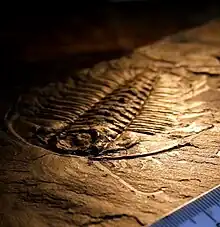| Part of a series on |
| Paleontology |
|---|
 |
|
Paleontology Portal Category |
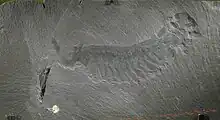
A Lagerstätte (German: [ˈlaːɡɐˌʃtɛtə], from Lager 'storage, lair' Stätte 'place'; plural Lagerstätten) is a sedimentary deposit that exhibits extraordinary fossils with exceptional preservation—sometimes including preserved soft tissues. These formations may have resulted from carcass burial in an anoxic environment with minimal bacteria, thus delaying the decomposition of both gross and fine biological features until long after a durable impression was created in the surrounding matrix. Lagerstätten span geological time from the Neoproterozoic era to the present. Worldwide, some of the best examples of near-perfect fossilization are the Cambrian Maotianshan shales and Burgess Shale, the Ordovician Soom Shale, the Silurian Waukesha Biota, the Devonian Hunsrück Slates and Gogo Formation, the Carboniferous Mazon Creek, the Triassic Madygen Formation, the Jurassic Posidonia Shale and Solnhofen Limestone, the Cretaceous Yixian, Santana, and Agua Nueva formations, the Eocene Green River Formation, the Miocene Foulden Maar and Ashfall Fossil Beds, the Pliocene Gray Fossil Site, the Pleistocene Naracoorte Caves, the La Brea Tar Pits, and the Tanis Fossil Site.
Types
Palaeontologists distinguish two kinds:[1]
- Konzentrat-Lagerstätten (concentration Lagerstätten) are deposits with a particular "concentration" of disarticulated organic hard parts, such as a bone bed. These Lagerstätten are less spectacular than the more famous Konservat-Lagerstätten. Their contents invariably display a large degree of time averaging, as the accumulation of bones in the absence of other sediment takes some time. Deposits with a high concentration of fossils that represent an in situ community, such as reefs or oyster beds, are not considered Lagerstätten.
- Konservat-Lagerstätten (conservation Lagerstätten) are deposits known for the exceptional preservation of fossilized organisms or traces. The individual taphonomy of the fossils varies with the sites. Conservation Lagerstätten are crucial in elucidating important moments in the history and evolution of life. For example, the Burgess Shale of British Columbia is associated with the Cambrian explosion, and the Solnhofen limestone with the earliest known bird, Archaeopteryx.
.jpg.webp)
_(Bear_Gulch_Limestone%252C_Upper_Mississippian%253B_Montana%252C_USA)_(33784748875).jpg.webp)
Preservation
Konservat-Lagerstätten preserve lightly sclerotized and soft-bodied organisms or traces of organisms that are not otherwise preserved in the usual shelly and bony fossil record; thus, they offer more complete records of ancient biodiversity and behavior and enable some reconstruction of the palaeoecology of ancient aquatic communities. In 1986, Simon Conway Morris calculated only about 14% of genera in the Burgess Shale had possessed biomineralized tissues in life. The affinities of the shelly elements of conodonts were mysterious until the associated soft tissues were discovered near Edinburgh, Scotland, in the Granton Lower Oil Shale of the Carboniferous.[2] Information from the broader range of organisms found in Lagerstätten have contributed to recent phylogenetic reconstructions of some major metazoan groups. Lagerstätten seem to be temporally autocorrelated, perhaps because global environmental factors such as climate might affect their deposition.[3]
A number of taphonomic pathways may produce Lagerstätten. The following is an incomplete list:
- Orsten-type and Doushantuo-type preservations preserve organisms in phosphate.
- Bitter Springs-type preservation preserves them in silica.
- Carbonaceous films are the result of Burgess Shale-type preservation
- Pyrite preserves exquisite detail in Beecher's trilobite-type preservation.
- Ediacaran-type preservation preserves casts and moulds with the aid of microbial mats.
Important Lagerstätten
The world's major Lagerstätten include:
Precambrian
| Site(s) | Age | Location | Significance | Notable fossils/organisms |
|---|---|---|---|---|
| Nonesuch Formation | 1083-1070 Ma | Michigan, USA | A Mesoproterozoic lake containing exceptionally preserved limnic microbes.[4] | |
|
Lakhanda Lagerstätte |
1030-1000 Ma |
Uchur-Maya Depression, Russia |
A site preserving evidence of trophic interactions from the Boring Billion.[5][6] | |
|
1000–850 Ma |
South Australia |
Preserved fossils include cyanobacteria microfossils. |
_(Neoproterozoic%252C_~800_Ma%253B_Bitter_Springs%252C_Australia)_1_(41559714260).jpg.webp) An early Stromatolite | |
| Dolores Creek Formation | 950 Ma | Yukon, Canada | An Early Tonian site containing pyritised macroalgal fossils.[7] | |
|
Chichkan Lagerstätte |
775 Ma |
Kazakhstan |
A site from the transition between the prokaryote-dominated biota of the Early Neoproterozoic and the eukaryote-dominated biota of the Late Neoproterozoic and Phanerozoic.[8] | |
|
600–555 Ma |
Guizhou Province, China |
Spans the poorly understood interval between the end of the Cryogenian period and the Late Ediacaran Avalon explosion. |
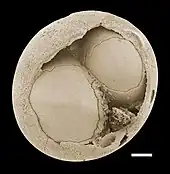 An ediacaran embryo-like fossil | |
| Portfjeld Formation | 570 Ma | North Greenland | A Middle Ediacaran biota from the continent of Laurentia exhibiting Doushantuo-type preservation.[9] | |
|
565 Ma |
Newfoundland, Canada |
This site contains one of the most diverse and well-preserved collections of Precambrian fossils. |
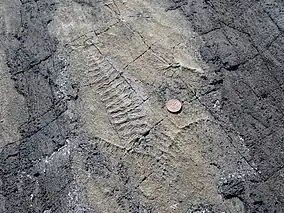 Frondose ediacaran organisms | |
|
555 Ma |
South Australia |
The type location the Ediacaran period, and has preserved a significant amount of fossils from that time. |
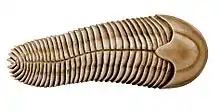 Spriggina floundersi, a worm-like organism | |
| Shibantan Lagerstätte | 551-543 Ma | Hubei, China | A terminal Ediacaran fossil assemblage preserving life forms living just before the Proterozoic-Phanerozoic transition.[10] | |
| Gaojiashan Lagerstätte | 551-541 Ma | Shaanxi, China | A lagerstätte documenting tube growth patterns of Cloudina.[11] | |
|
Khatyspyt Lagerstätte |
544 Ma |
Yakutia, Russia |
A Late Ediacaran lagerstätte preserving an Avalon-type biota.[12] | |
Cambrian
| Site(s) | Age | Location | Significance | Notable fossils/organisms |
|---|---|---|---|---|
|
Maotianshan Shales (Chengjiang) |
518 Ma |
Yunnan, China |
The preservation of an extremely diverse faunal assemblage renders the Maotianshan shale the world's most important for understanding the evolution of early multi-cellular life. |
 Haikouichthys, a primitive craniate |
|
518 Ma |
Hubei, China |
This site is particularly notable due to both the large proportion of new taxa represented (approximately 53% of the specimens), and the notable volume of soft-body tissue preservation. |
 Duplapex, a hymenocarine arthropod | |
|
523-518 Ma |
A site known for its fauna, and that they were most likely preserved by a death mask. It is a part of the larger Buen Formation, and has a fauna similar to the Maotianshan shales. |
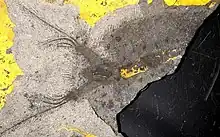 | ||
|
Sinsk Algal Lens |
518 Ma |
One of the oldest known Cambrian Lagerstätten. The fauna of this site is unique, as it seems that they were adapted to living in dysaerobic conditions.[13] |
 A reconstruction of the large Lobopodian Siberion | |
|
513 Ma |
Noted soft tissue mineralization, most often of blocky apatite or fibrous calcium carbonate, including the oldest phosphatized muscle tissue. |
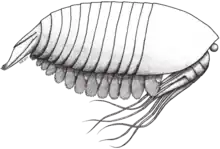 Oestokerkus, a megacheiran arthropod | ||
|
513–501 Ma |
Guizhou, China |
The middle part of the Kaili Formation, the Oryctocephalus indicus Zone, contains a Burgess Shale-type Lagerstätte with many well-preserved fossils known collectively as the Kaili Biota. |
_(Kaili_Formation%252C_Middle_Cambrian%253B_quarry_between_Balang_%2526_Dunzhou%252C_Guizhou_Province%252C_China).jpg.webp) Pararotadiscus a cambroernid animal | |
|
Murero Lagerstätte |
511-503 Ma |
Spain |
Thanks to the paleontological content, mainly trilobites, fourteen biozones have been established, the most precise biozonation for this time interval in the world. It also records in detail the so-called Valdemiedes event, the mass extinction episode at the end of the Lower Cambrian.[14] |
 Eccaparadoxides trilobites showing sexual dimorphism |
|
~510–500 Ma |
Central Wisconsin, US |
This site preserves some of the oldest evidence of multicellular life walking out of the ocean, and onto dry land (in the form of large mollusks and euthycarcinoid arthropods). Other notable fossils include stranded scyphozoans, and some of the oldest true crustaceans (in the form of phyllocarids). |
 Mosineia, a euthycarcinoid arthropod | |
|
508 Ma |
British Columbia, Canada |
One of the most famous fossil localities in the world. It is famous for the exceptional preservation of the soft parts of its fossils. At 508 million years old (middle Cambrian), it is one of the earliest fossil beds containing soft-part imprints. |
 Anomalocaris, a predatory radiodont | |
|
507 Ma |
A site known for its abundant Cambrian trilobites and the preservation of Burgess Shale-type fossils. The type locality for this site is Spence Gulch in southeastern Idaho. |
 Hyoliths, most likely lophophorates | ||
|
Linyi Lagerstätte |
504 Ma |
A lagerstätte recognised for its exceptional preservation of arthropod limbs, intestines, and eyes.[15] |
 Restoration of the Linyi Lagerstätte | |
|
504 Ma |
Western Utah, US |
A world-famous locality known for its prolific agnostid and Elrathia kingii trilobite remains. Varied soft bodied organisms are also locally preserved, including Naraoia, Wiwaxia and Hallucigenia. |
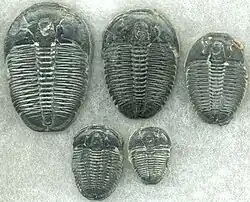 Elrathia sp. trilobites | |
|
502 Ma |
Western Utah, US |
A site known for its occasional preservation of soft-bodied tissue, and diverse assemblage. |
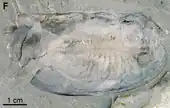 Branchiocaris a pelagic hymenocarine | |
|
500 Ma |
Western Utah, US |
A site that is dominated by trilobites and brachiopods, but also comprising various soft-bodied organisms, such as Falcatamacaris. |
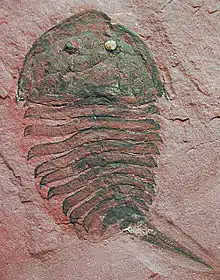 Beckwithia, an aglaspidid trilobite relative | |
|
Kinnekulle Orsten and Alum Shale |
500 Ma |
The Orsten sites reveals the oldest well-documented benthic meiofauna in the fossil record. Fossils such as microfossils of arthropods like free-living pentastomids are known. Multiple "Orsten-type" Lagerstätten are also known from other countries. |
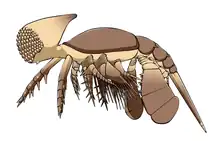 Cambropachycope, a stem-group mandibulate arthropod | |
Ordovician
| Site(s) | Age | Location | Significance | Notable fossils/organisms |
|---|---|---|---|---|
|
about 485 Ma |
Draa Valley, Morocco |
It was deposited in a marine environment, and is known for its exceptionally preserved fossils, filling an important preservational window beyond the earlier and more common Cambrian Burgess shale-type deposits. |
 Aegirocassis, a giant hurdiid radiodont | |
|
Liexi fauna |
About 470 Ma (early-middle Floian) |
Hunan Province, China |
Preserves Early Ordovician fauna with soft tissue, includes not only Cambrian relics but also taxa originated during Ordovician.[16] | |
|
About 461 Ma |
Llandrindod Wells, Wales |
A unique environment deposited during the middle Ordovician that possibly shows iconic groups from Cambrian lagerstättes, like Opabiniids and Megacheirans, survived for longer than what was thought. |
 Diagram of Mieridduryn, an opabiniid-like panarthropod | |
|
460 Ma |
Tennessee, US |
Low-diversity assemblage of arthropod fossils, which are preserved well because of volcanic ash. |
 | |
|
460 Ma |
A Middle Ordovician site known for exceptionally exquisite preservation of conodonts, and the earliest eurypterids in the fossil record.[18] |
 Pentecopterus, the oldest known eurypterid | ||
|
460? Ma |
New York, US |
Noted exceptionally preserved trilobites with soft tissue preserved by pyrite replacement. |
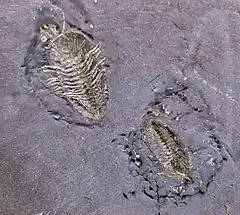 A pair of Triarthrus trilobites with pyritized soft-tissue | |
|
? (Sandbian) |
Colorado, US |
Although preservation is not excellent, this lagoonal site provides early vertebrate fossils such as Astraspis and Eriptychius. |
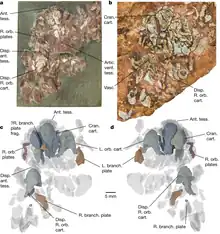 Eriptychius, an early agnathan | |
|
about 455? Ma |
New York, US |
This site is an excellent example of an obrution (rapid burial or "smothered") Lagerstätte. |
_(16763508314).jpg.webp) Isotelus gigas, a large asaphid trilobite | |
| Big hill Lagerstätte | about 450? Mya | Michigan, US | A site known for its preservation of soft-bodied medusae (jellyfish), as well as linguloid brachiopods, algae, and arthropods (namely chasmataspidids, leperditid ostracods, and eurypterids). | 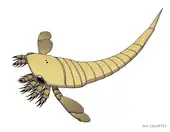 Hoplitaspis, chasmataspid arthropod |
|
Brechin Lagerstätte |
450 Ma |
Ontario, Canada |
Known for preserving one of the most diverse crinoid fauna of the Katian.[19] |
|
|
450? Ma |
South Africa |
Known for its remarkable preservation of soft-tissue in fossil material. Deposited in still waters, the unit lacks bioturbation, perhaps indicating anoxic conditions. |
| |
|
Tafilalt Biota |
Tafilalt, Morocco |
Known from range of non-biomineralised and soft-bodied organisms in polar environment.[20] |
| |
|
? (middle Katian) |
Manitoba, Canada |
Fossils like algae, conulariids and trilobites are known from this site. | ||
|
449-445.6 Ma |
Manitoulin, Canada |
Low-diversity assemblage of arthropod fossils. |
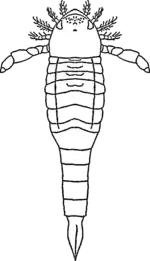 Orcanopterus, a middle-sized waeringopterid eurypterid | |
|
William Lake (Stony Mountain Formation)[17] |
445 Ma |
Manitoba, Canada |
Well-preserved fossils like jellyfish, xiphosurans, sea spiders are known from this site, it is important since many of the fossils are unknown in other Ordovician sites. |
 Lunataspis aurora, an early xiphosuran known in two sites |
|
Airport Cove[17] |
445 Ma |
Manitoba, Canada |
Fossils like eurypterids, algae and xiphosurans are preserved in this site. | |
Silurian
| Site(s) | Age | Location | Significance | Notable fossils/organisms |
|---|---|---|---|---|
|
Kalana Lagerstätte |
~440 Ma |
Estonia |
Known for well preserved fossils of algae and crinoids.[21] |
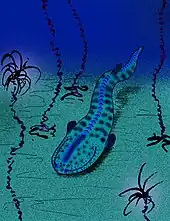 Kalanaspis, the earliest known osteostracan |
|
Chongqing Lagerstätte (Huixingshao Formation)[22] |
436 Ma |
Chongqing, China |
This site preserved complete fossils of earliest jawed vertebrates, as well as some galeaspids and eurypterids. |
 Xiushanosteus, the earliest placoderm |
|
~435 Ma |
Wisconsin, US |
Well-studied site known for the exceptional preservation of its diverse, soft-bodied and lightly skeletonized fauna, includes many major taxa found nowhere else in strata of similar age. |
 Parioscorpio, an enigmatic arthropod | |
|
Herefordshire Lagerstätte (Coalbrookdale Formation) |
~430 Ma |
Known for the well-preserved fossils of various invertebrate animals many of which are in their three-dimensional structures. Fossils are preserved within volcanic ash, because of that sometimes this site has been compared to Pompeii.[23] Some of the fossils are regarded as earliest evidences and evolutionary origin of some of the major groups of modern animals. |
| |
|
~425 Ma |
Known for preservation of both hard and soft bodied organisms in great detail. |
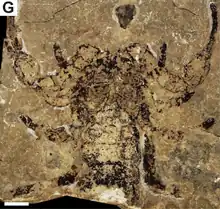 Eramoscorpius, an early scorpion | ||
|
422.9-416 Ma |
Ontario & New York State |
This limestone have produced thousands of fossil eurypterids, such as giant Acutiramus and well-known Eurypterus, as well as other fauna like scorpions and fish. |
||
|
~420 Ma |
Pennsylvania, US |
Known from exceptionally preserved mass assemblage of Eurypterus, the most abundant eurypterid in the fossil record. | 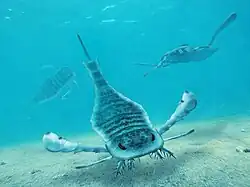 Recobstruction of Eurypterus | |
|
415 Ma[25] |
New York, US and Ontario, Canada |
Echinoderms (such as crinoids) and trilobites are known from Lewiston Member in this shale. | _(15273506362).jpg.webp) Arctinurus, one of the trilobites from this site | |
Devonian
| Site(s) | Age | Location | Significance | Notable fossils/organisms |
|---|---|---|---|---|
| Rhynie chert | 400 Ma | Scotland, UK | The Rhynie chert contains exceptionally preserved plant, fungus, lichen and animal material preserved in place by an overlying volcanic deposit. As well as one of the first known fully terrestrial ecosystems. | 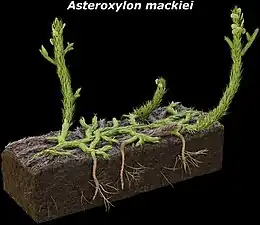 |
| Waxweiler Lagerstätte (Klerf Formation) | 409-392 Ma | Eifel, Germany | Waxweiler Lagerstätte is known from well-preserved fossils of chelicerates, giant claw of Jaekelopterus rhenaniae shows the largest arthropod ever known. |  Jaekelopterus, around 2.5 m-long eurypterid |
| Heckelmann Mill | 395 Ma | Rhineland-Palatinate, Germany | Heckelmann Mill preserves well preserved rhinocaridid archaeostracan phyllocarids,[26] along with exceptionally abundant crinoid holdfasts from the late Emsian.[27] | |
| Hunsrück Slates (Bundenbach) | 390 Ma | Rheinland-Pfalz, Germany | The Hunsrück slates are one of the few marine Devonian Lagerstätte having soft tissue preservation, and in many cases fossils are coated by a pyritic surface layer. | 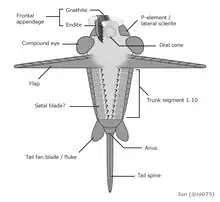 Schinderhannes bartelsi, the youngest known radiodont |
| Gogo Formation | 380 Ma (Frasnian) | Western Australia | The fossils of the Gogo Formation display three-dimensional soft-tissue preservation of tissues as fragile as nerves and embryos with umbilical cords. Over fifty species of fish have been described from the formation, and arthropods. |  |
| Miguasha National Park (Escuminac Formation) | 370 Ma | Québec, Canada | Some of the fish, fauna, and spore fossils found at Miguasha are rare and ancient species. For example, Eusthenopteron is sarcopterygian that shares characters with early tetrapods. |  |
| Kowala Lagerstätte | ~368 Ma | Świętokrzyskie Voivodeship, Poland | A Late Devonian site known for its fossils of non-biomineralised algae and arthropods.[28] | |
| Maïder Basin | 368 Ma (for Thylacocephalan Layer) | Anti-Atlas, Morocco | Thylacocephalan Layer and Hangenberg Black Shale in this basin provides well-preserved fossils of Famennian fauna, including chondrichthyans and placoderms that preserved soft tissues.[29] |  Amazichthys, pelagic placoderm with preserved soft tissue |
| Strud[30] | ? (Late Famennian) | Namur Province, Belgium | Mainly juvenile placoderms are known, suggesting this site would be nursery site of placoderms.[31] Various biota like tetrapods, arthropods and plants are also known, Strudiella from this site may be the earliest insect, but its affinity is disputed. | 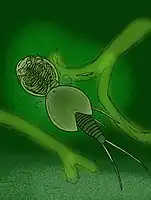 Strudops, the earliest known notostracan. |
| Canowindra, New South Wales (Mandagery Sandstone) | 360 Ma | Australia | An accidentally discovered Lagerstätte known for its exceptional preservation of Sarcopterygian and Placoderm fish. | 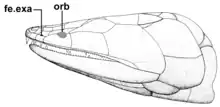 Mandageria, a lobe-finned fish that is the NSW State Fossil Emblem in Australia |
| Waterloo Farm lagerstätte (Witpoort Formation) | 360 Ma | South Africa | Important site that providing the only record of a high latitude (near polar) coastal ecosystem, overturning numerous assumptions about high latitude conditions during the latest Devonian. | 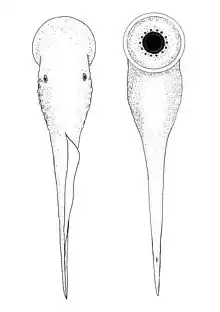 Priscomyzon, the oldest known genus of lamprey |
Carboniferous
| Site(s) | Age | Location | Significance | Notable fossils/organisms |
|---|---|---|---|---|
| Granton Shrimp Bed | ? (Dinantian) | Firth of Forth, Scotland | Dominated by well-preserved crustacean fossils, this site provided first body fossil of Clydagnathus which solved long-lasted mystery of conodont fossils. | |
| East Kirkton Quarry[32] | 335 Ma | West Lothian, Scotland | This site has produced numerous well-preserved fossils of early tetrapods like temnospondyls or reptiliomorphs, and large arthropods like scorpions or eurypterids. |  Silvanerpeton, a possible reptiliomorph |
| Bear Gulch Limestone | 324 Ma | Montana, US | A limestone-rich geological lens in central Montana. It is renowned for its unusual and ecologically diverse fossil composition of chondrichthyans, the group of cartilaginous fish containing modern sharks, rays, and chimaeras. Other animals like brachiopods, ray finned fish, arthropods, and the possible mollusk Typhloesus are also known from the site. |  Falcatus, a holocephalian which males had large fin spine |
| Bickershaw[33] | ? (Langsettian) | Lancashire, England | This locality contains exceptionally preserved fossils within nodules. Arthropods have greater diversity, many of which are aquatic ones that lived in brackish environment. |  Valloisella, a xiphosuran |
| Joggins Fossil Cliffs (Joggins Formation) | 315 Ma | Nova Scotia, Canada | A fossil site that preserves a diverse terrestrial ecosystem consisting of plants like lycopsids, giant arthropods, fish, and the oldest known sauropsid, Hylonomus. |  Hylonomus, the oldest known sauropsid in the fossil record |
| Linton Diamond Coal Mine[34][35] | 310 Ma | Ohio, US | A site known for its number of prehistoric tetrapods, like the lepospondyl Diceratosaurus.[36] | 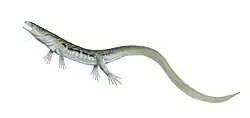 The lepospondyl tetrapod Diceratosaurus |
| Mazon Creek | 310 Ma | Illinois, US | A conservation lagerstätte found near Morris, in Grundy County, Illinois. The fossils from this site are preserved in ironstone concretions with exceptional detail. The state fossil of Illinois, the enigmatic animal Tullimonstrum, is only known from these deposits. | 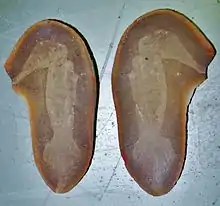 Tullimonstrum, an enigmatic animal |
| Kinney Brick Quarry (Atrasado Formation) | around 307 Ma | New Mexico, US | This site is known from rich fish fossils with preserved soft tissues, that lived in lagoonal environment. Dozens of fish genera are known, ranging from chondrichthyeans like ctenacanths and hybodonts, to actinopterygians and sarcopterygians.[37] | |
| Montceau-les-Mines | 300 Ma | France | Exceptional preservation of Late Carboniferous fossil biota are known, including various vertebrates and arthropods, as well as plants.[38][39] | 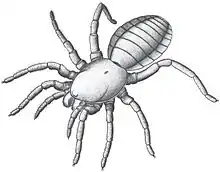 |
| Hamilton Quarry | 300 Ma | Kansas, US | This site is known for its diverse assemblage of unusually well-preserved marine, euryhaline, freshwater, flying, and terrestrial fossils (invertebrates, vertebrates, and plants). This extraordinary mix of fossils suggests it was once an estuary. | 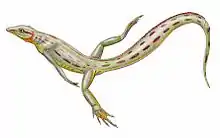 Spinoaequalis, a semi-aquatic diapsid |
| Carrizo Arroyo | ? (Latest Gzhelian to earliest Asselian) | New Mexico, US | This site is known from exceptional preservation of arthropod fossils, mainly insects.[40] | |
Permian
| Site(s) | Age | Location | Significance | Notable fossils/organisms |
|---|---|---|---|---|
| Franchesse | 292 Ma | Massif Central, France | A Sakmarian seymouriamorph lagerstätte from the Bourbon l'Archambault Basin in the French Massif Central containing hundreds of complete seymouriamorph specimens.[41] | |
| Chemnitz petrified forest | 291 Ma | Saxony, Germany | A petrified forest in Germany that is composed of Arthropitys bistriata, a type of Calamites, giant horsetails that are ancestors of modern horsetails, found on this location with never seen multiple branches. Many more plants and animals from this excavation are still in an ongoing research.[42] |  Large trunks of Arthropitys at Chemnitz |
| Mangrullo Formation | about 285–275 Ma (Artinskian) | Uruguay | This site is known for its abundant mesosaur fossils. It also contains the oldest known Konservat-Lagerstätte in South America, as well as the oldest known fossils of amniote embryos.[43] | 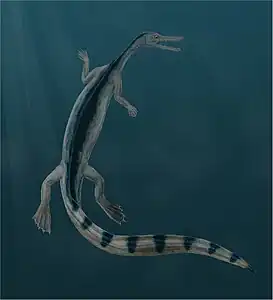 Stereosternum, an aquatic mesosaurid reptile |
| Chekarda (Koshelevka Formation) | about 283–273 Ma | Perm, Russia | Over 260 species of insect species are described from this site as well as diverse taxa of plants, making it one of the most important Permian Konservat-Lagerstätten.[44] | |
| Toploje Member | 273-264 Ma | Prince Charles Mountains, Antarctica | This site preserves a high-latitude fauna in exceptional position before the large extinctions that happened later in the Permian.[45] | |
| Onder Karoo | 266.9–264.28 Ma | Karoo Basin, South Africa | A high latitude, cool-temperate lacustrine ecosystem preserving detailed plant and insect fossils.[46] | |
| Sakamena Group[47] | 260–247 Ma | Madagascar | Lower Sakamena Formation (Permian) and Middle Sakamena Formation (Triassic) contain fossils of animals lived around wetland environment, such as semi-aquatic and gliding neodiapsids. |  Claudiosaurus, aquatic neodiapsid reptile |
| Kupferschiefer | 259–255 Ma | Central Europe | This site deposited in an open marine and shallow marine environment provides fossils of reptiles as well as many fish. |  Weigeltisaurus, gliding weigeltisaurid reptile |
| Huopu Lagerstätte | ~255 Ma | Guizhou, China | A plant fossil site documenting floral dynamics between the end-Guadalupian and end-Permian extinction events.[48] | |
Triassic
| Site(s) | Age | Location | Significance | Notable fossils/organisms |
|---|---|---|---|---|
| Guiyang biota[49] | 250.8 Ma | Guizhou Province, China | The oldest known Mesozoic lagerstätte (Dienerian). It preserves taxa belonging to 12 classes and 19 orders, including several species of fish. |  |
| Paris biota[50] | ~249 Ma | Idaho, Nevada, USA | This earliest Spathian aged assemblage preserves fossils belonging to 7 phyla and 20 orders, combining Paleozoic groups (e.g. leptomitid protomonaxonid sponges otherwise known from the early Paleozoic) with members of the Modern evolutionary fauna (e.g. gladius-bearing coleoids). | 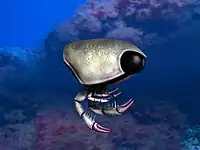 Ankitokazocaris triassica is a thylacocephalan from the Paris biota |
| Jialingjiang Formation[51] | 249.2–247.2 Ma | Hubei Province, China | This site preserved aquatic reptiles soon after Permian extinction. Hupehsuchians are exclusively known from here, and already got unique ecology like filter feeding. |  Eretmorhipis, a hupehsuchian that potentially had platypus-like ecology |
| Nanlinghu Formation[51] | 248 Ma | Anhui Province, China | This site provides important fossils to show early evolution of ichthyosauriforms. | 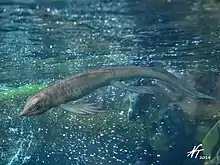 Cartorhynchus, a primitive ichthyosauriform |
| Petropavlovka Formation | 248 Ma | Orenburg Oblast, Russia | A site known for preserving oligochaetes, whose fossil record is extremely sparse.[52] | |
| Luoping Biota (Guanling Formation)[53] | ~247-245 Ma | Yunnan, China | Various marine animals are preserved in this site, showing how marine ecosystem recovered after Permian extinction. |  Atopodentatus, a herbivorous marine reptile that possessed a hammer-shaped head. |
| Grès à Voltzia | 245 Ma | France | A fossil site remarkable for its detailed myriapod specimens.[54] | |
| Besano Formation[51] | 242 Ma | Alps, Italy and Switzerland | This formation is designated as a World Heritage Site, as it is famous for its preservation of Middle Triassic marine life including fish and aquatic reptiles. | Tanystropheus, a long-necked archosauromorph |
| Xingyi biota (Zhuganpo Formation)[51] | ? (Upper Ladinian - Lower Carnian) | Guizhou and Yunnan, China | Previously considered as part of Falang Formation, this site yields many articulated skeletons of marine reptiles, as well as fish and invertebrates. |  Keichousaurus, common sauropterygian from this site |
| Guanling biota (Xiaowa Formation)[51] | ? (Carnian) | Guizhou, China | Like Xingi Biota, this site also yields well-preserved marine fauna, especially many species of thalattosaurs are known. | 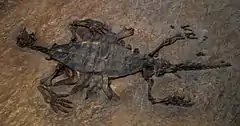 |
| Polzberg | 233 Ma | Austria | A site known for exceptional preservation of bromalites[55] and of cartilage,[56] deposited during the Carnian Pluvial Event.[57] | |
| Madygen Formation | 230 Ma | Kyrgyzstan | The Madygen Formation is renowned for the preservation of more than 20,000 fossil insects, making it one of the richest Triassic Lagerstätten in the world. Other vertebrate fossils as fish, amphibians, reptiles and synapsids have been recovered from the formation too, as well as minor fossil flora. | 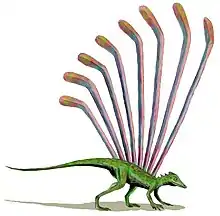 Longisquama, a bizarre reptile with long growths protruding from its back |
| Cow Branch Formation | 230 Ma | Virginia, US | This site preserves a wide variety of organisms (including Fish, reptiles, arachnids, and insects). | 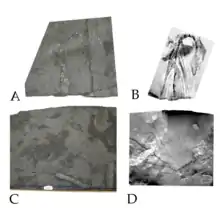 Mecistotrachelos, a gliding reptile distantly related to archosauromorphs, like crocodylians and dinosaurs |
Jurassic
| Site(s) | Age | Location | Significance | Notable fossils/organisms |
|---|---|---|---|---|
| Osteno (Moltrasio Formation)[58] | 196-188 Ma | Italy | Several kinds of marine biota such as fish, crustaceans, cephalopods polychaetes, and nematodes have been recovered. This site is the only fossil deposit in Italy in which soft bodies are preserved other than Monte Bolca. |  Squaloraja, ray-like chimaeriform |
| Ya Ha Tinda | 183 Ma | Alberta, Canada | A fossil site notable for containing abundant and extremely well-preserved vampire squid, being the largest concentration of vampire squid fossils outside the Tethys Ocean,[59] and for being deposited during the Toarcian Oceanic Anoxic Event (TOAE).[60][61][62] | |
| Strawberry Bank | 183 Ma | Somerset, England | A site from the TOAE documenting marine life during the recovery from the Triassic-Jurassic extinction event as well as the turmoil of the TOAE.[63] The oldest pseudoplanktonic barnacles in the fossil record,[64] near-complete ichthyosaur skeletons,[65] and evidence of ichthyosaur niche partitioning are preserved at this site.[66] | |
| Holzmaden/Posidonia Shale | 183 Ma | Württemberg, Germany | The Sachrang member is among the most important formations of the Toarcian boundary, due to the concentrations of exceptionally well-preserved complete skeletons of fossil marine fish and reptiles. It was also deposited during the TOAE.[67][68] |  A specimen of the ichthyosaur Stenopterygius crassicostatus with preserved young |
| Monte Fallano | ? (Bajocian-Bathonian) | Campania, Italy | This Plattenkalk preserves fossils of terrestrial plants, crustaceans and fish.[69] | |
| Mesa Chelonia[70] | 164.6 Ma | Shanshan County, China | This site is notable because it contains a large turtle bonebed, containing specimens of the genus Annemys. This bonebed contains up to an estimated 36 turtles per square meter. | |
| La Voulte-sur-Rhône | 160 Mya | Ardèche, France | La Voulte-sur-Rhône, in the Ardèche region of southwestern France, offers paleontologists an outstanding view of an undisturbed paleoecosystem that was preserved in fine detail. Notable finds include retinal structures in the eyes of thylacocephalan arthropods, and fossilized relatives of the modern day vampire squid, like Vampyronassa rhodanica. | 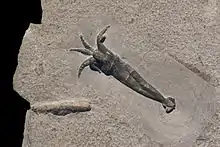 A rare well-preserved cephalopod, Rhomboteuthis |
| Karabastau Formation | 155.7 Ma | Kazakhstan | This site is an important locality for insect fossils that has been studied since the early 20th century, alongside the rarer remains of vertebrates, including pterosaurs, salamanders, lizards and crocodiles. | |
| Tiaojishan Formation | 165-153 Ma | Liaoning Province, China | It is known for its exceptionally preserved fossils, including those
of plants, insects and vertebrates. It is made up mainly of pyroclastic rock interspersed with basic volcanic and sedimentary rocks. |
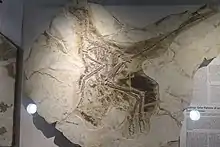 Anchiornis, small feathered anchiornithid dinosaur |
| Talbragar fossil site[71] | 151 Ma | New South Wales, Australia | This bed is part of Purlawaugh Formation, and provided fauna like fish and insects that lived around the lake. | 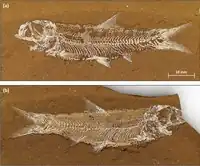 Cavenderichthys, a teleost known from this site |
| Cleveland-Lloyd Dinosaur Quarry | 150 Ma | Utah, US | Jurassic National Monument, at the site of the Cleveland-Lloyd Dinosaur Quarry, well known for containing the densest concentration of Jurassic dinosaur fossils ever found, is a paleontological site located near Cleveland, Utah, in the San Rafael Swell, a part of the geological layers known as the Morrison Formation. Up to 15,000 have been excavated from this site alone. |  Allosaurus, the largest predator of the quarry |
| Solnhofen Limestone | 145 Ma | Bavaria, Germany | This site is unique as it preserves a rare assemblage of fossilized organisms, including highly detailed imprints of soft bodied organisms such as sea jellies. The most familiar fossils of the Solnhofen Plattenkalk include the early feathered theropod dinosaur Archaeopteryx preserved in such detail that they are among the most famous and most beautiful fossils in the world. | .jpg.webp) The Berlin Specimen of Archaeopteryx lithographica |
| Canjuers Lagerstätte | 145 Ma | France | This site shows a high amount of biodiversity, including reptiles, invertebrates, fish, and other organisms. |  Pleurosaurus, an aquatic rhynchocephalian |
| Agardhfjellet Formation | 150-140 Ma | Spitsbergen, Norway | The formation contains the Slottsmøya Member, a highly fossiliferous unit where many ichthyosaur and plesiosaur fossils have been found, as well as abundant and well preserved fossils of invertebrates. |  |
Cretaceous
| Site(s) | Age | Location | Significance | Notable fossils/organisms |
|---|---|---|---|---|
| Angeac-Charente | ~141 Ma | Charente, France | A lagerstätte preserving both vertebrate and invertebrate fossils from the poorly represented Berriasian stage known for its taphonomic and sedimentological ‘frozen scenes’.[72] | |
| El Montsec (La Pedrera de Rúbies Formation) | ~140-125 Ma | Catalonia, Spain | Known from exceptional preservation of fossils like insect and other arthropod fossils, as well as some vertebrates. | 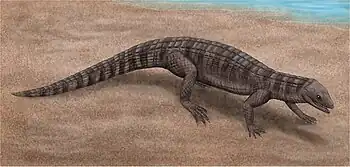 Montsecosuchus, atoposaurid crocodylomorph |
| Las Hoyas | about 125 Ma (Barremian) | Cuenca, Spain | The site is mostly known for its exquisitely preserved dinosaurs, especially enantiornithines. The lithology of the formation mostly consists of lacustarine limestone deposited in a freshwater wetland environment. |  Concornis, an early enantiornithean |
| Yixian Formation | about 125–121 Ma | Liaoning, China | The Yixian Formation is well known for its great diversity of well-preserved specimens and its feathered dinosaurs, such as the large tyrannosauroid Yutyrannus, the therizinosaur Beipiaosaurus, and various small birds, along with a selection of other dinosaurs, such as the iguanodontian Bolong, the sauropod Dongbeititan and the ceratopsian Psittacosaurus. Other biota included the troodontid Mei, the dromaeosaurid Tianyuraptor, and the compsognathid Sinosauropteryx. | 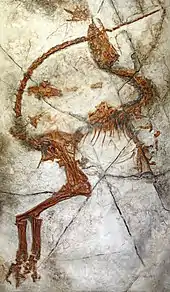 Sinosauropteryx, the first non-avain dinosaur with evidence of feathers to have been recognized |
| Jiufotang Formation | about 122-119 Ma (Aptian) | Liaoning, China | This formation overlies the slightly older Yixian Formation and preserved very similar species, including a wide variety of dinosaurs such as the ceratopsian Psittacosaurus and the early bird Confuciusornis, both of which are also found in the Yixian Formation. Also notable are the very abundant specimens of the dromaeosaurid Microraptor, which is known from up to 300 specimens and is among the most common animals found here. |  Microraptor had four wings and is believed to have evolved powered flight independently of true birds. |
| Shengjinkou Formation | about 120 Ma | Xinjiang, China | Part of the finds from this site consisted of dense concentrations of pterosaur bones, associated with soft tissues and eggs. The site represented a nesting colony that storm floods had covered with mud. Dozens of individuals could be secured from a total that in 2014 was estimated to run into the many hundreds. | 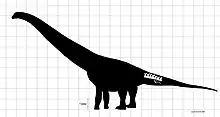 Hamititan, a large titanosaurian sauropod |
| Xiagou Formation | about 120–115? Ma | Gansu, China | This site is known outside the specialized world of Chinese geology as the site of a Lagerstätte in which the fossils were preserved of Gansus yumenensis, the earliest true modern bird. |  Gansus is among the earliest known modern birds |
| Paja Formation | 130-113 Ma | Colombia | This site is famous for its vertebrate fossils and is the richest Mesozoic fossiliferous formation of Colombia. Several marine reptile fossils of plesiosaurs, pliosaurs, ichthyosauras and turtles have been described from the formation and it hosts the only dinosaur fossils described in the country to date; Padillasaurus. | 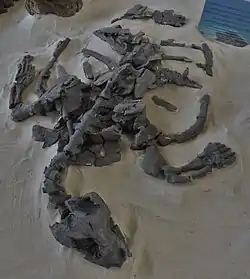 Desmatochelys, a protostegid and one of the oldest known turtle fossils |
| Koonwarra Fossil Bed[73] | around 118-115 Ma | Victoria, Australia | This site is composed of mudstone sediment thought to have been laid down in a freshwater lake. Arthropods, fish and plant fossils are known from this site. | |
| Crato Formation | 113 Ma | northeast Brazil | The Crato Formation earns the designation of Lagerstätte due to an exceedingly well preserved and diverse fossil faunal assemblage. Some 25 species of fossil fishes are often found with stomach contents preserved, enabling paleontologists to study predator-prey relationships in this ecosystem. There are also fine examples of pterosaurs, reptiles and amphibians, invertebrates (particularly insects), and plants. Also known from this site is Ubirajara, the first non-avian dinosaur from the southern hemisphere with evidence of feathers. | 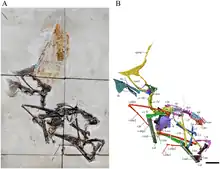 Tupandactylus, a fossil pterosaur that was preserved with feathers and other soft tissues intact |
| Jinju Formation | 112.4–106.5 Ma | South Korea | An ichnofossil assemblage notable for preserving the longest Cretaceous lepidosaur trackway.[74] | 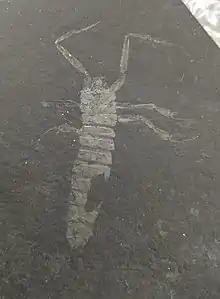 Coptoclavidae beetle larva preserved at this locality |
| Tlayúa Formation | 110 Ma | Puebla, Mexico | A marine lagerstätte preserving Albian actinopterygians.[75] | 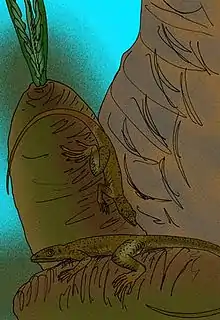 Huehuecuetzpalli, possible bipedal lizard |
| Romualdo Formation | 108–92 Ma | Brazil | The Romualdo Formation is a part of the Santana Group and has provided a rich assemblage of fossils; flora, fish, arthropods insects, turtles, snakes, dinosaurs, such as Irritator, and pterosaurs, including the genus Thalassodromeus. The stratigraphic units of the group contained several feathers of birds, among those the first record of Mesozoic birds in Brazil. |  Tapejara, a common pterosaur in Brazil during the Early Cretaceous |
| Muhi Quarry (El Doctor Formation) | ? (Albian to Cenomanian, probably Late Albian)[76] | Hidalgo, Mexico | While this site produced limestones for construction, rocks in that locality contain a diverse Cretaceous marine biota such as fish, ammonites and crustaceans. | 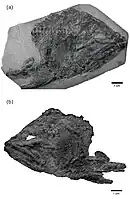 Motlayoichthys, a member of Pachyrhizodontidae |
| Puy-Puy Lagerstätte | 100.5 Ma | France | A paralic site preserving a variety of ichnofossils,[77] along with some vertebrate remains.[78] The site preserves evidence of plant-insect interaction.[79] | |
| Burmese Amber | 99 Ma | Myanmar | More than 1,000 species of taxa have been described from ambers from Hukawng Valley. While it is important for understanding the evolution of biota, mainly insects, during the Cretaceous period, it is also extremely controversial by facing ethical issues due to its association with conflicts and labor conditions. |  Oculudentavis, small-sized lizard |
| Haqel/Hjoula/al-Nammoura | about 95 Ma | Lebanon | Notable among these is the Lebanese lagerstätten of the Late Cretaceous age, which contain a well-preserved variety of different fossils. Small animals like shrimp, octopus, stingrays, and bony fishes are common finds at these sites. Some of the rarest fossils from this locality include those of octopuses. | |
| Vallecillo (Agua Nueva Formation) | 94–92 Ma | Nuevo León, Mexico | The site is noted for its qualities as a Konservat-Lagerstätte, with notable finds including the plesiosaur Mauriciosaurus and the possible shark Aquilolamna. | |
| Akrabou Formation (Gara Sbaa and Agoult)[80] | ? (Turonian) | Asfla, Morocco | Marine site known for exceptionally preserved, three-dimensional fish fossils. | |
| Smoky Hill Chalk | 87–82 Ma | Kansas and Nebraska, US | A Cretaceous conservation Lagerstätte known primarily for its exceptionally well-preserved marine reptiles. Also known from this site are fossils of large bony fish such as Xiphactinus, mosasaurs, flying reptiles or pterosaurs (namely Pteranodon), flightless marine birds such as Hesperornis, and turtles. |  Xiphactinus is famous for being found with another fish (Gillicus) preserved in its stomach. |
| Ingersoll Shale | 85 Ma | Alabama, US | A Late Cretaceous (Santonian) informal geological unit in eastern Alabama. Fourteen theropod feathers assigned to birds and possibly dromaeosaurids have been recovered from the unit. | |
| Auca Mahuevo | 80 Ma | Patagonia, Argentina | A Cretaceous lagerstätte in the eroded badlands of the Patagonian province of Neuquén, Argentina. The sedimentary layers of the Anacleto Formation at Auca Mahuevo were deposited between 83.5 and 79.5 million years before the present and offers a view of a fossilized titanosaurid nesting site. |  An egg from a titanosaurian sauropod |
| Nardò (Calcari di Melissano)[81] | ? (upper Campanian-lower Maastrichtian) | Apulia, Italy | This site is especially famous for its limestones containing abundant fossil fish remains. |  Nardovelifer, the earliest lampriform |
| Harrana (Muwaqqar Chalk Marl Formation) | ? (Late Maastrichtian) | Jordan | Phosphatic deposits formed in this site are known to preserve vertebrate fossils with soft tissue, such as mosasaurs, plesiosaurs, sharks, bony fish, turtles and crocodylians.[82] | 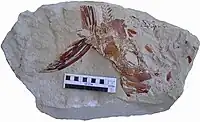 Postredectes, an example of fish fossil from this site |
| Zhucheng (Wangshi Group) | 66 Ma | Shandong, China | Zhucheng has been an important site for dinosaur excavation since 1960. The world's largest hadrosaurid fossil (Shantungosaurus) was found in Zhucheng in the 1980s. Other dinosaurs known from the area include the ceratopsian Zhuchengceratops (2010), the sauropod Zhuchengtitan (2017) and the theropod Zhuchengtyrannus (2011) which have all been described from deposits near and named after Zhucheng. |  Zhuchengtyrannus, an Asian relative of the larger Tyrannosaurus |
| Tanis[83] | 66 Ma | North Dakota, US | Tanis is part of the heavily studied Hell Creek Formation, a group of rocks spanning four states in North America renowned for many significant fossil discoveries from the Upper Cretaceous and lower Paleocene. Tanis is a significant site because it appears to record the events from the first minutes until a few hours after the impact of the giant Chicxulub asteroid in extreme detail. This impact, which struck the Gulf of Mexico 66.043 million years ago, wiped out all non-avian dinosaurs and many other species (the so-called "K-Pg" or "K-T" extinction). |  Some of the fossil fish from the Tanis site |
Palaeogene
| Site(s) | Age | Location | Significance | Notable fossils/organisms |
|---|---|---|---|---|
|
Menat |
60 Ma |
Auvergne, France |
A Palaeocene maar lake containing three-dimensional plant remains.[84] | |
|
55–53 Ma |
Preserves abundant fossil fish, insects, reptiles, birds and plants. The Fur Formation was deposited about 55 Ma, just after the Palaeocene-Eocene boundary, and its tropical or sub-tropical flora indicate that the climate after the Paleocene-Eocene Thermal Maximum was moderately warm (approximately 4-8 degrees warmer than today). |
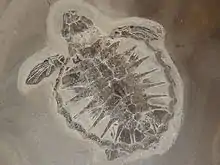 Tasbacka danica, immature sea turtle | ||
|
54–48 Ma |
England, UK |
Collected for close to 300 years, Plant fossils, especially seeds and fruits, are found in abundance. |
.jpg.webp) A Tynskya eocaena fossil | |
|
52 - 48 Ma |
British Columbia, Canada & Washington, USA |
Includes McAbee Fossil Beds, Princeton chert & Klondike Mountain Formation; Recognized as temperate/subtropical uplands right after the Paleocene–Eocene Thermal Maximum and spanning the Early Eocene Climatic Optimum, preserves highly detailed uplands lacustrine fauna and flora. |
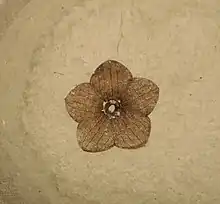 A Florissantia quilchenensis flower, an extinct malvaceous genus from western North America | |
|
50 Ma |
Colorado/Utah/Wyoming, US |
An Eocene aged site that is noted for the fish fauna preserved. Other fossils include the crocodilians, birds, and mammals. |
 Diplomystus and Knightia | |
|
49 Ma |
Verona, Italy |
A fossil site with specimens of fish and other organisms that are so highly preserved that their organs are often completely intact in fossil form, and even the skin color can sometimes be determined. It is assumed that mud at the site was low in oxygen, preventing both decay and the mixing action of scavengers from harming the fossils. |
 A complete Archaeophis proavus | |
|
49 Ma |
Hessen, Germany |
This site has significant geological and scientific importance. Over 1000 species of plants and animals have been found at the site. After almost becoming a landfill, strong local resistance eventually stopped these plans and the Messel Pit was declared a UNESCO World Heritage Site on 9 December 1995. Significant scientific discoveries about the early evolution of mammals and birds are still being made at the Messel Pit, and the site has increasingly become a tourist site as well. |
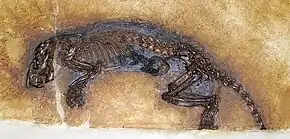 Masillamys sp., an ischyromyid rodent | |
| Kishenehn Formation | 46.2 Ma | Montana | A Middle Eocene site preserving exquisitely detailed insect specimens in oil shale.[85] | |
| Mahenge | 46 Ma | Tanzania | A terrestrial Middle Eocene lagerstätte preserving plant and arthropod fossils.[86][87] | |
|
45-25 Ma |
South-Western France |
This site qualifies as a Lagerstätte because beside a large variety of mammals, birds, turtles, crocodiles, flora and insects, it also preserves the soft tissues of amphibians and squamates, in addition to their articulated skeleton in what has been called natural mummies. |
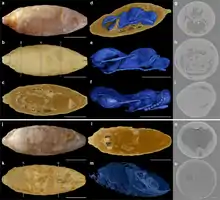 Xenomorphia resurrecta parasitic wasps preserved in fly pupae | |
|
34 Ma |
Colorado |
A late Eocene (Priabonian) aged site that is noted for the finly preserved plant and insect paleobiota. Fossils are preserved in diatom blooms of a lahar dammed lake system and the formation is noted for the petrified stumps of Sequoia affinis |
| |
| Rauenberg | 30 Ma | Baden-Württemberg, Germany | A marine fossil site with an Arctic-like invertebrate fauna and a Paratethyan vertebrate fauna displaying evidence of intermittent anoxia.[89] | |
|
Enspel Lagerstätte |
24.79-24.56 Ma |
Rhineland-Palatinate, Germany |
||
| Aix-en-Provence | ~24 Ma | Provence, France | A terminal Oligocene brackish palaeoenvironment.[91] | |
Neogene
| Site(s) | Age | Location | Significance | Notable fossils/organisms |
|---|---|---|---|---|
| Dominican amber | 30–10 Ma | Dominican Republic | Dominican amber differentiates itself from Baltic amber by being nearly always transparent, and it has a higher number of fossil inclusions. This has enabled the detailed reconstruction of the ecosystem of a long-vanished tropical forest.[92] |  A larval Amblyomma tick preserved in amber. |
| Riversleigh | 25–15 Ma | Queensland, Australia | This locality is recognised for the series of well preserved fossils deposited from the Late Oligocene to the Miocene. The fossiliferous limestone system is located near the Gregory River in the north-west of Queensland, an environment that was once a very wet rainforest that became more arid as the Gondwanan land masses separated and the Australian continent moved north. |  Reconstruction of the diprotodont marsupial Nimbadon lavarackorum. |
| Foulden Maar | 23 Ma | Otago, New Zealand | These layers of diatomite have preserved exceptional fossils of fish from the crater lake, and plants, spiders, and insects from the sub-tropical forest that developed around the crater,[93] along with in situ pollen.[94] | .jpg.webp) The teleost fish species Galaxias effusus. |
| Chiapas amber | 23-15 Ma | Chiapas, Mexico[95] | As with other ambers, a wide variety of taxa have been found as inclusions including insects and other arthropods, as well as plant fragments and epiphyllous fungi. | 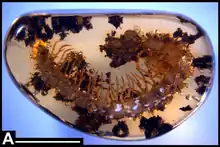 The holotype specimen of the millipede Anbarrhacus adamantis. |
| Clarkia fossil beds | 20-17 Ma | Idaho, US | The Clarkia fossil beds site is best known for its fossil leaves. Their preservation is exquisite; fresh leaves are unfossilized, and sometimes retain their fall colors before rapidly oxidizing in air. It has been reported that scientists have managed to isolate small amounts of ancient DNA from fossil leaves from this site. However, other scientists are skeptical of the validity of this reported occurrence of Miocene DNA. |  A leaf fossil from the beds after being exposed to oxygen. |
| Barstow Formation | 19–13.4 Ma | California, US | The sediments are fluvial and lacustrine in origin except for nine layers of rhyolitic tuff. It is well known for its abundant vertebrate fossils including bones, teeth and footprints. The formation is also renowned for the fossiliferous concretions in its upper member, which contain three-dimensionally preserved arthropods. | 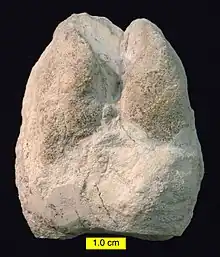 A fossilized footprint made by a camel. |
| Shanwang Formation | 18-17 Ma | Shandong Province, China | Fossils have been found at this site in dozens of categories, representing over 600 separate species. Animal fossils include insects, fish, spiders, amphibians, reptiles, birds and mammals. Insect fossils have clear, intact veins. Some have retained beautiful colours. | |
| Morozaki Group[96] | 18-17 Ma | Aichi Prefecture, Japan | Known from well-preserved deep sea fauna including fish, starfish and arthropods like crabs, shrimps and giant amphiopods. | |
| Sandelzhausen | 16 Ma | Bavaria, Germany | A Middle Miocene vertebrate locality.[97] | |
| McGraths Flat | ~16-11 Ma | NSW, Australia | Deposited in unusual conditions that record microscopic details of soft tissues and delicate structures. Fossil evidence of animals with soft bodies, unlike the bones of mammals and reptiles, is rare in Australia, and discoveries at McGraths' Flat have revealed unknown species of invertebrates such as insects and spiders.[98] | |
| Pisco Formation | 15-2 Ma | Arequipa & Ica, Peru | Several specialists consider the Pisco Formation one of the most important Lagerstätten, based on the large amount of exceptionally preserved marine fossils, including sharks (most notably megalodon), penguins, whales, dolphins, birds, marine crocodiles and aquatic giant sloths. | 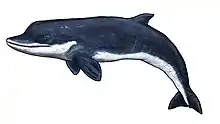 |
| Hindon Maar | 14.6 Ma | New Zealand | A maar preserving a Southern Hemisphere lake-forest ecosystem, including body fossils of plants, insects, fish, and birds,[99] along with in situ pollen[94] and coprolites of both fish and birds.[99] | |
| Ngorora Formation | 13.3-9 Ma | Tanzania | The alkaline palaeolake deposits of the Ngorora Formation contains articulated fish fossils that died en masse from asphyxiation during episodic ash falls or from rapid acidification.[100] | |
| Pi Gros | 13 Ma | Catalonia, Spain | An ichnofossil lagerstätte containing annelid, mollusc, and sponge trace fossils. The fossil site no longer exists due to having been quarried for the construction of an industrial park.[101] | |
| Bullock Creek | 12 Ma | Northern Territory, Australia | Among the fossils at the Bullock Creek site have been found complete marsupial crania with delicate structures intact. New significant taxa identified from the Bullock Creek mid Miocene include a new genus of crocodile, Baru (Baru darrowi), a primitive true kangaroo, Nambaroo, with high-crowned lophodont teeth; and a new species of giant horned tortoise, Meiolania. New marsupial lion, thylacine, and dasyurid material has also been recovered. | |
| Tunjice | ? (Middle Miocene) | Slovenia | This site is known worldwide for the earliest fossil records of seahorses.[102] |  Two fossil seahorse species, Hippocampus sarmaticus and H. slovenicus from this site. |
| Ashfall Fossil Beds | 11.83 Ma | Nebraska, US | The Ashfall Fossil Beds of Antelope County in northeastern Nebraska are rare fossil sites of the type called lagerstätten that, due to extraordinary local conditions, capture an ecological "snapshot" in time of a range of well-preserved fossilized organisms. Ash from a Yellowstone hotspot eruption 10-12 million years ago created these fossilized bone beds. |  A bone-bed containing the fossils of the basal rhino Teleoceras and the three-toed horse Cormohipparion. |
| Alcoota Fossil Beds | 8 Ma | Northern Territory, Australia | It is notable for the occurrence of well-preserved, rare, Miocene vertebrate fossils, which provide evidence of the evolution of the Northern Territory's fauna and climate. The Alcoota Fossil Beds are also significant as a research and teaching site for palaeontology students. | 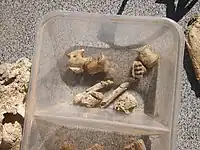 Miscellaneous fossils of several macropod marsupials |
| Saint-Bauzile | 7.6-7.2 Ma | Ardèche, France | A Late Miocene site preserving articulated mammal skeletons with skin and fur impressions.[103] | |
| Tresjuncos | 6 Ma | Cuenca, Spain | A Late Miocene lacustrine Konservat-Lagerstätte containing fossils of diatoms, plants, crustaceans, insects, and amphibians.[104] | |
| Gray Fossil Site | 4.9-4.5 Ma | Tennessee, US | As the first site of its age known from the Appalachian region, the Gray Fossil Site is a unique window into the past. Research at the site has yielded many surprising discoveries, including new species of red panda, rhinoceros, pond turtle, hickory tree, and more. The site also hosts the world's largest known assemblage of fossil tapirs. | |
Quaternary
| Site(s) | Age | Location | Significance | Notable fossils/organisms |
|---|---|---|---|---|
| The Mammoth Site | 26 Ka | South Dakota, US | The facility encloses a prehistoric sinkhole that formed and was slowly filled with sediments during the Pleistocene era. As of 2016, the remains of 61 mammoths, including 58 North American Columbian and 3 woolly mammoths had been recovered. Mammoth bones were found at the site in 1974, and a museum and building enclosing the site were established. |  Fossil skeleton of Arctodus simus, a large species of "short-faced" bear that was one of North America's largest predators during the Pleistocene. |
| Rancho La Brea Tar Pits | 40–12 Ka | California, US | A group of tar pits where natural asphalt (also called asphaltum, bitumen, or pitch; brea in Spanish) has seeped up from the ground for tens of thousands of years. Over many centuries, the bones of trapped animals have been preserved. Among the prehistoric species associated with the La Brea Tar Pits are Pleistocene mammoths, dire wolves, short-faced bears, American lions, ground sloths, and, the state fossil of California, the saber-toothed cat (Smilodon fatalis). |  Fossil skeleton of Mammuthus columbi excavated from the tar pits |
| Waco Mammoth National Monument | 65–51 Ka | Texas, US | A paleontological site and museum in Waco, Texas, United States where fossils of 24 Columbian mammoths (Mammuthus columbi) and other mammals from the Pleistocene Epoch have been uncovered. The site is the largest known concentration of mammoths dying from a (possibly) reoccurring event, which is believed to have been a flash flood. |  Fossil skeleton of a mammoth found at the Waco site |
| El Breal de Orocual | 2.5–1 Ma | Monagas, Venezuela | The largest asphalt well on the planet. Like the La Brea Tar Pits, this site preserves a number of megafauna like toxodonts, glyptodonts, camelids, and the felid Homotherium venezuelensis. | 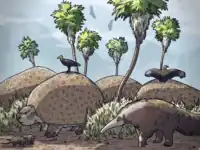 Restoration of the environment at El Breal de Orocual, showing Glyptodon, Coragyps, Dasypus and Myrmecophaga |
| El Mene de Inciarte | 28-25.5 Ka | Zulia, Venezuela | Another series of tar pits. These also preserve a similar assemblage of megafauna. | |
| Naracoorte Caves | 500-1 Ka | South Australia, Australia | A series of caves that preserve numerous pleistocene megafauna, like Thylacoleo, and is recognized as a World heritage site alongside the older, but geographically similar Riversleigh site. | 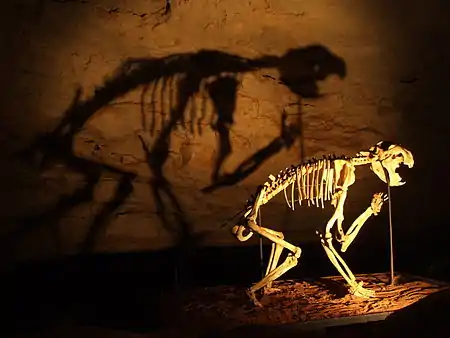 Skeleton of Thylacoleo at the Naracoorte Caves |
See also
- List of fossil sites (with link directory)
- Hoard, a concentration of human artifacts useful for similar reasons in archaeology
References
- ↑ The term was originally coined by Adolf Seilacher in: Seilacher, A. (1970). "Begriff und Bedeutung der Fossil-Lagerstätten: Neues Jahrbuch fur Geologie und Paläontologie". Monatshefte (in German). 1970: 34–39.
- ↑ Briggs et al. 1983; Aldridge et al. 1993.
- ↑ Retallack, G. J. (2011). "Exceptional fossil preservation during CO2 greenhouse crises?". Palaeogeography, Palaeoclimatology, Palaeoecology. 307 (1–4): 59–74. Bibcode:2011PPP...307...59R. doi:10.1016/j.palaeo.2011.04.023.
- ↑ Strother, Paul K.; Wellman, Charles H. (30 November 2020). "The Nonesuch Formation Lagerstätte: a rare window into freshwater life one billion years ago". Journal of the Geological Society. 178 (2): 1–12. doi:10.1144/jgs2020-133. S2CID 229003508. Retrieved 18 June 2023.
- ↑ Shuvalova, J. V.; Nagovitsin, K. E.; Parkhaev, P. Yu. (26 February 2021). "Evidences of the Oldest Trophic Interactions in the Riphean Biota (Lakhanda Lagerstätte, Southeastern Siberia)". Doklady Biological Sciences. 496 (1): 34–40. doi:10.1134/S0012496621010105. PMID 33635488. S2CID 254411264. Retrieved 30 April 2023.
- ↑ Podkovyrov, Victor N. (September 2009). "Mesoproterozoic Lakhanda Lagerstätte, Siberia: Paleoecology and taphonomy of the microbiota". Precambrian Research. 173 (1–4): 146–153. Bibcode:2009PreR..173..146P. doi:10.1016/j.precamres.2009.04.006. Retrieved 30 April 2023.
- ↑ Maloney, Katie M.; Schiffbauer, James D.; Halverson, Galen P.; Xiao, Shuhai; Laflamme, Marc (13 April 2022). "Preservation of early Tonian macroalgal fossils from the Dolores Creek Formation, Yukon". Scientific Reports. 12 (1): 6222. Bibcode:2022NatSR..12.6222M. doi:10.1038/s41598-022-10223-x. PMC 9007953. PMID 35418588.
- ↑ Sergeev, Vladimir N.; Schopf, J. William (1 May 2010). "Taxonomy, paleoecology and biostratigraphy of the late Neoproterozoic Chichkan microbiota of South Kazakhstan: The marine biosphere on the eve of metazoan radiation". Journal of Paleontology. 84 (3): 363–401. Bibcode:2010JPal...84..363S. doi:10.1666/09-133.1. S2CID 140668863. Retrieved 30 April 2023.
- ↑ Willman, Sebastian; Peel, John S.; Ineson, Jon R.; Schovsbo, Niels H.; Rugen, Elias J.; Frei, Robert (6 November 2020). "Ediacaran Doushantuo-type biota discovered in Laurentia". Communications Biology. 3 (1): 647. doi:10.1038/s42003-020-01381-7. PMC 7648037. PMID 33159138.
- ↑ Xiao, Shuhai; Chen, Zhe; Pang, Ke; Zhou, Chuanming; Yuan, Xunlai (12 October 2020). "The Shibantan Lagerstätte: insights into the Proterozoic–Phanerozoic transition". Journal of the Geological Society. 178: 1–11. doi:10.1144/jgs2020-135. S2CID 225242787. Retrieved 30 April 2023.
- ↑ Cai, Yaoping; Hua, Hong; Schiffbauer, James D.; Sun, Bo; Yuan, Xunlai (April 2014). "Tube growth patterns and microbial mat-related lifestyles in the Ediacaran fossil Cloudina, Gaojiashan Lagerstätte, South China". Gondwana Research. 25 (3): 1008–1018. Bibcode:2014GondR..25.1008C. doi:10.1016/j.gr.2012.12.027. Retrieved 18 June 2023.
- ↑ Duda, Jan-Peter; Love, Gordon D.; Rogov, Vladimir I.; Melnyk, Dmitry S.; Blumenberg, Martin; Grazhdankin, Dmitriy V. (3 September 2020). "Understanding the geobiology of the terminal Ediacaran Khatyspyt Lagerstätte (Arctic Siberia, Russia)". Geobiology. 18 (6): 643–662. Bibcode:2020Gbio...18..643D. doi:10.1111/gbi.12412. PMID 32881267. S2CID 221477265. Retrieved 30 April 2023.
- ↑ Ivantsov, Andrey Yu.; Zhuravlev, Andrey Yu.; Leguta, Anton V.; Krassilov, Valentin A.; Melnikova, Lyudmila M.; Ushatinskaya, Galina T. (2 May 2005). "Palaeoecology of the Early Cambrian Sinsk biota from the Siberian Platform". Palaeogeography, Palaeoclimatology, Palaeoecology. 220 (1–2): 69–88. Bibcode:2005PPP...220...69I. doi:10.1016/j.palaeo.2004.01.022. Retrieved 12 November 2022.
- ↑ Gámez Vintaned, J. A.; Liñán, E. y Gozalo, R. (2013) «Los trilobites cámbricos de la Biota de Murero (Zaragoza, España)». Cuadernos de Paleontología Aragonesa, 7: 5-27
- ↑ Sun, Z.; Zhao, F.; Zeng, H.; Luo, C.; Van Iten, H.; Zhu, M. (2022). "The middle Cambrian Linyi Lagerstätte from the North China Craton: a new window on the Cambrian evolutionary fauna". National Science Review. 9 (7): nwac069. doi:10.1093/nsr/nwac069. PMC 9273334. PMID 35832778. Retrieved 2 April 2023.
- ↑ Fang, Xiang; Mao, Yingyan; Liu, Qi; Yuan, Wenwei; Chen, Zhongyang; Wu, Rongchang; Li, Lixia; Zhang, Yuchen; Ma, Junye; Wang, Wenhui; Zhan, Renbin; Peng, Shanchi; Zhang, Yuandong; Huang, Diying (13 July 2022). "The Liexi fauna: a new Lagerstätte from the Lower Ordovician of South China". Proceedings of the Royal Society B: Biological Sciences. 289 (1978). doi:10.1098/rspb.2022.1027. ISSN 0962-8452. PMC 9277276. PMID 35858062.
- 1 2 3 4 5 6 Young, Graham; Rudkin, David; Dobrzanski, Edward; Robson, Sean; Cuggy, Michael; Demski, Matthew; Thompson, Deborah (2012). "Great Canadian Lagerstätten 3. Late Ordovician Konservat-Lagerstätten in Manitoba". Geoscience Canada. 39 (4): 201–213. ISSN 0315-0941.
- ↑ Liu, Huaibao P.; Bergström, Stig M.; Witzke, Brian J.; Briggs, Derek E. G.; McKay, Robert M.; Ferretti, Annalisa (28 February 2017). "Exceptionally preserved conodont apparatuses with giant elements from the Middle Ordovician Winneshiek Konservat-Lagerstätte, Iowa, USA". Journal of Paleontology. 91 (3): 493–511. Bibcode:2017JPal...91..493L. doi:10.1017/jpa.2016.155. S2CID 132698401. Retrieved 18 March 2023.
- ↑ Selina R. Cole; David F. Wright; William I. Ausich (1 May 2019). "Phylogenetic community paleoecology of one of the earliest complex crinoid faunas (Brechin Lagerstätte, Ordovician)". Palaeogeography, Palaeoclimatology, Palaeoecology. 521: 82–98. Bibcode:2019PPP...521...82C. doi:10.1016/j.palaeo.2019.02.006. S2CID 135129430. Retrieved 10 April 2023.
- ↑ García-Bellido, Diego C.; Gutiérrez-Marco, Juan Carlos (29 October 2022). "Polar gigantism and remarkable taxonomic longevity in new palaeoscolecid worms from the Late Ordovician Tafilalt Lagerstätte of Morocco". Historical Biology. 35 (11): 2011–2021. doi:10.1080/08912963.2022.2131404. ISSN 0891-2963. S2CID 253297071.
- ↑ Ausich, William I.; Wilson, Mark A.; Tinn, Oive (14 May 2019). "Kalana Lagerstätte crinoids: Early Silurian (Llandovery) of central Estonia". Journal of Paleontology. 94 (1): 131–144. doi:10.1017/jpa.2019.27. S2CID 181399467. Retrieved 27 April 2023.
- ↑ Zhu, You-an; Li, Qiang; Lu, Jing; Chen, Yang; Wang, Jianhua; Gai, Zhikun; Zhao, Wenjin; Wei, Guangbiao; Yu, Yilun; Ahlberg, Per E.; Zhu, Min (2022). "The oldest complete jawed vertebrates from the early Silurian of China". Nature. 609 (7929): 954–958. Bibcode:2022Natur.609..954Z. doi:10.1038/s41586-022-05136-8. ISSN 1476-4687. PMID 36171378. S2CID 252569910.
- ↑ BBC. "Fossils found in 425 million year old 'Pompeii'". www.bbc.co.uk. Retrieved 7 October 2023.
- ↑ Vrazo, Matthew B.; Trop, Jeffrey M.; Brett, Carlton E. (2014). "A New Eurypterid Lagerstätte from the Upper Silurian of Pennsylvania". PALAIOS. 29 (7/8): 431–448. Bibcode:2014Palai..29..431V. doi:10.2110/palo.2014.003. ISSN 0883-1351. JSTOR 43683811. S2CID 30066085.
- ↑ Taylor, Wendy L. (28 October 1999), "Middle Silurian Rochester Shale of Western New York, USA, and Southern Ontario, Canada", Fossil Crinoids, Cambridge University Press, pp. 87–92, doi:10.1017/cbo9780511626159.012, ISBN 9780521450249, retrieved 9 October 2023
- ↑ Poschmann, Markus J. (3 February 2021). "A new phyllocarid (Crustacea, Archaeostraca) from the Early Devonian (late Emsian) Heckelmann Mill Fossil-Lagerstätte (Lahn Syncline, Rhineland-Palatinate, SW-Germany)". PalZ. 95: 27–36. doi:10.1007/s12542-020-00535-6. S2CID 231793893. Retrieved 29 April 2023.
- ↑ Poschmann, Markus J. (15 July 2019). "Pelmatozoan "rooting grounds" from the Early Devonian (late Emsian) Heckelmann Mill Fossil-Lagerstätte (Lahn Syncline, Rhineland-Palatinate, SW-Germany): morphological, palaeoenvironmental and taphonomic aspects". PalZ. 94 (2): 311–325. doi:10.1007/s12542-019-00454-1. S2CID 198137119. Retrieved 29 April 2023.
- ↑ Zatoń, Michał; Filipiak, Paweł; Rakociński, Michał; Krawczyński, Wojciech (25 March 2014). "Kowala Lagerstätte: Late Devonian arthropods and non-biomineralized algae from Poland". Lethaia. 47 (3): 352–364. doi:10.1111/let.12062. Retrieved 29 June 2023.
- ↑ Frey, Linda; Pohle, Alexander; Rücklin, Martin; Klug, Christian (2020). "Fossil‐Lagerstätten, palaeoecology and preservation of invertebrates and vertebrates from the Devonian in the eastern Anti‐Atlas, Morocco". Lethaia. 53 (2): 242–266. doi:10.1111/let.12354. ISSN 0024-1164. S2CID 210627752.
- ↑ Denayer, Julien; Prestianni, Cyrille; Gueriau, Pierre; Olive, Sébastien; Clément, Gaël (2016). "Stratigraphy and depositional environments of the Late Famennian (Late Devonian) of Southern Belgium and characterization of the Strud locality". Geological Magazine. 153 (1): 112–127. Bibcode:2016GeoM..153..112D. doi:10.1017/S001675681500031X. ISSN 0016-7568. S2CID 129070535.
- ↑ Olive, Sébastien; Clément, Gaël; Daeschler, Edward B.; Dupret, Vincent (23 August 2016). "Placoderm Assemblage from the Tetrapod-Bearing Locality of Strud (Belgium, Upper Famennian) Provides Evidence for a Fish Nursery". PLOS ONE. 11 (8): e0161540. Bibcode:2016PLoSO..1161540O. doi:10.1371/journal.pone.0161540. ISSN 1932-6203. PMC 4994939. PMID 27552196.
- ↑ Fraser, Nicholas C.; Sues, Hans-Dieter (2017). Terrestrial Conservation Lagerstätten: Windows Into the Evolution of Life on Land. Dunedin Academic Press. ISBN 978-1-78046-014-7.
- ↑ Anderson, Lyall I.; Dunlop, Jason A.; Horrocks, Carl A.; Winkelmann, Heather M.; Eagar, R. M. C. (1997). "Exceptionally preserved fossils from Bickershaw, Lancashire UK (Upper Carboniferous, Westphalian A (Langsettian))". Geological Journal. 32 (3): 197–210. doi:10.1002/(SICI)1099-1034(199709)32:3<197::AID-GJ739>3.0.CO;2-6.
- ↑ "Direct Evidence of Food Chains at the Linton Lagerstatte". gsa.confex.com.
- ↑ Dunne, Emma M. (1 July 2020). Patterns and drivers of tetrapod diversity and biogeography in the late Palaeozoic and early Mesozoic (d_ph thesis). University of Birmingham.
- ↑ Hook, Robert W.; Baird, Donald (19 June 1986). "The Diamond Coal Mine of Linton, Ohio, and its Pennsylvanian-age vertebrates". Journal of Vertebrate Paleontology. 6 (2): 174–190. Bibcode:1986JVPal...6..174H. doi:10.1080/02724634.1986.10011609. ISSN 0272-4634.
- ↑ M. Hodnett, John-Paul; Lucas, Spencer G. "Review Of The Late Pennsylvanian Fish Assemblage From The Kinney Brick Quarry, New Mexico". New Mexico Museum of Natural History and Science Bulletin. 84: 359–390.
- ↑ Perrier, V.; Charbonnier, S. (2014). "The Montceau-les-Mines Lagerstätte (Late Carboniferous, France)". Comptes Rendus Palevol. 13 (5): 353–67. Bibcode:2014CRPal..13..353P. doi:10.1016/j.crpv.2014.03.002.
- ↑ Heyler, Daniel; Poplin, Cecile M. (1988). "The Fossils of Montceau-les-Mines". Scientific American. 259 (3): 104–111. Bibcode:1988SciAm.259c.104H. doi:10.1038/scientificamerican0988-104. ISSN 0036-8733. JSTOR 24989233.
- ↑ "NMGS 2016 Guidebook Details". New Mexico Geological Society. doi:10.56577/ffc-67.377. Retrieved 18 December 2023.
- ↑ Steyer, J.-Sébastien; Sanchez, Sophie; Debriette, Pierre J.; Valli, Andrea M. F.; Escuille, François; Pohl, Burkhard; Dechambre, Roger-Paul; Vacant, Renaud; Spence, Christopher; De Ploëg, Gaël (1 December 2012). "A new vertebrate Lagerstätte from the Lower Permian of France (Franchesse, Massif Central): palaeoenvironmental implications for the Bourbon-l'Archambault basin". Bulletin de la Société Géologique de France. 183 (6): 509–515. doi:10.2113/gssgfbull.183.6.509. Retrieved 29 April 2023.
- ↑ Luthardt, Ludwig; Rößler, Ronny; Schneider, Joerg W. (1 January 2016). "Palaeoclimatic and site-specific conditions in the early Permian fossil forest of Chemnitz—Sedimentological, geochemical and palaeobotanical evidence". Palaeogeography, Palaeoclimatology, Palaeoecology. 441: 627–652. Bibcode:2016PPP...441..627L. doi:10.1016/j.palaeo.2015.10.015. Retrieved 8 June 2022.
- ↑ Piñeiro, G.; Ramos, A.; Goso, C. S.; Scarabino, F.; Laurin, M. (2012). "Unusual Environmental Conditions Preserve a Permian Mesosaur-Bearing Konservat-Lagerstätte from Uruguay". Acta Palaeontologica Polonica. 57 (2): 299–318. doi:10.4202/app.2010.0113.
- ↑ Khramov, Alexander V.; Naugolnykh, Sergey V.; Węgierek, Piotr (12 September 2022). "Possible long-proboscid insect pollinators from the Early Permian of Russia". Current Biology. 32 (17): 3815–3820.e2. doi:10.1016/j.cub.2022.06.085. ISSN 0960-9822.
- ↑ Slater, Ben J.; McLoughlin, Stephen; Hilton, Jason (June 2015). "A high-latitude Gondwanan lagerstätte: The Permian permineralised peat biota of the Prince Charles Mountains, Antarctica". Gondwana Research. 27 (4): 1446–1473. Bibcode:2015GondR..27.1446S. doi:10.1016/j.gr.2014.01.004.
- ↑ Prevec, Rosemary; Nel, André; Day, Michael O.; Muir, Robert A.; Matiwane, Aviwe; Kirkaldy, Abigail P.; Moyo, Sydney; Staniczek, Arnold; Cariglino, Bárbara; Maseko, Zolile; Kom, Nokuthula; Rubidge, Bruce S.; Garrouste, Romain; Holland, Alexandra; Barber-James, Helen M. (30 October 2022). "South African Lagerstätte reveals middle Permian Gondwanan lakeshore ecosystem in exquisite detail". Communications Biology. 5 (1): 1154. doi:10.1038/s42003-022-04132-y. PMC 9618562. PMID 36310243.
- ↑ Benton, M. J. (6 November 1989). "Mass extinctions among tetrapods and the quality of the fossil record". Philosophical Transactions of the Royal Society of London. B, Biological Sciences. 325 (1228): 369–386. Bibcode:1989RSPTB.325..369B. doi:10.1098/rstb.1989.0094. ISSN 0080-4622. PMID 2574883.
- ↑ Neregato, R.; D'Apolito, C.; Glasspool, I. J.; Wang, S.-J.; Liu, F.; Windslow, P.; Lu, J.; Shao, L.; Hilton, J. (15 May 2016). "Palynological constraints on the provenance and stratigraphic range of a Lopingian (Late Permian) inter-extinction floral lagerstätte from the Xuanwei Formation, Guizhou Province, China". International Journal of Coal Geology. 162: 139–150. Bibcode:2016IJCG..162..139N. doi:10.1016/j.coal.2016.06.005. S2CID 132822933. Retrieved 18 June 2023.
- ↑ Dai, Xu; Davies, Joshua H.F.L.; Yuan, Zhiwei; Brayard, Arnaud; Ovtcharova, Maria; Xu, Guanghui; Liu, Xiaokang; Smith, Christopher P.A.; Schweitzer, Carrie E.; Li, Mingtao; Perrot, Morgann G.; Jiang, Shouyi; Miao, Luyi; Cao, Yiran; Yan, Jia; Bai, Ruoyu; Wang, Fengyu; Guo, Wei; Song, Huyue; Tian, Li; Dal Corso, Jacopo; Liu, Yuting; Chu, Daoliang; Song, Haijun (2023). "A Mesozoic fossil lagerstätte from 250.8 million years ago shows a modern-type marine ecosystem". Science. 379 (6632): 567–572. Bibcode:2023Sci...379..567D. doi:10.1126/science.adf1622. PMID 36758082. S2CID 256697946.
- ↑ Brayard, Arnaud; Krumenacker, L. J.; Botting, Joseph P.; Jenks, James F.; Bylund, Kevin G.; Fara, Emmanuel; Vennin, Emmanuelle; Olivier, Nicolas; Goudemand, Nicolas; Saucède, Thomas; Charbonnier, Sylvain; Romano, Carlo; Doguzhaeva, Larisa; Thuy, Ben; Hautmann, Michael; Stephen, Daniel A.; Thomazo, Christophe; Escarguel, Gilles (2017). "Unexpected Early Triassic marine ecosystem and the rise of the Modern evolutionary fauna". Science Advances. 3 (2): e1602159. Bibcode:2017SciA....3E2159B. doi:10.1126/sciadv.1602159. PMC 5310825. PMID 28246643.
- 1 2 3 4 5 Flannery Sutherland, Joseph T.; Moon, Benjamin C.; Stubbs, Thomas L.; Benton, Michael J. (27 February 2019). "Does exceptional preservation distort our view of disparity in the fossil record?". Proceedings of the Royal Society B: Biological Sciences. 286 (1897): 20190091. doi:10.1098/rspb.2019.0091. ISSN 0962-8452. PMC 6408902. PMID 30963850.
- ↑ Shcherbakov, Dmitry; Tarmo, Timm; Tzetlin, Alexander B.; Vinn, Olev; Zhuravlev, Andrey (April 2020). "A probable oligochaete from an Early Triassic Lagerstätte of the southern Cis-Urals and its evolutionary implications". Acta Palaeontologica Polonica. 65 (2): 219–233. doi:10.4202/app.00704.2019. S2CID 219097612. Retrieved 28 April 2023.
- ↑ Hu, Shi-xue; Zhang, Qi-yue; Chen, Zhong-Qiang; Zhou, Chang-yong; Lü, Tao; Xie, Tao; Wen, Wen; Huang, Jin-yuan; Benton, Michael J. (7 August 2011). "The Luoping biota: exceptional preservation, and new evidence on the Triassic recovery from end-Permian mass extinction". Proceedings of the Royal Society B: Biological Sciences. 278 (1716): 2274–2282. doi:10.1098/rspb.2010.2235. ISSN 0962-8452. PMC 3119007. PMID 21183583.
- ↑ Shear, W. A.; Selden, Paul A.; Gall, Jean-Claude (June 2009). "Millipedes from the Grès à Voltzia, Triassic of France, with comments on Mesozoic millipedes (Diplopoda: Helminthomorpha: Eugnatha)". International Journal of Myriapodology. 2 (1): 1–13. doi:10.1163/187525409X462395. Retrieved 18 June 2023.
- ↑ Lukeneder, Alexander; Surmik, Dawid; Gorzelak, Przemysław; Niedźwiedzki, Robert; Brachaniec, Tomasz; Salomon, Mariusz A. (25 November 2020). "Bromalites from the Upper Triassic Polzberg section (Austria); insights into trophic interactions and food chains of the Polzberg palaeobiota". Scientific Reports. 10 (1): 20545. doi:10.1038/s41598-020-77017-x. PMC 7689505. PMID 33239675.
- ↑ Lukeneder, P.; Lukeneder, A. (2022). "Mineralized belemnoid cephalic cartilage from the late Triassic Polzberg Konservat-Lagerstätte (Austria)". PLOS One. 17 (4): e0264595. Bibcode:2022PLoSO..1764595L. doi:10.1371/journal.pone.0264595. PMC 9020720. PMID 35442996.
- ↑ Lukeneder, Alexander; Lukeneder, Petra (17 August 2021). "The Upper Triassic Polzberg palaeobiota from a marine Konservat-Lagerstätte deposited during the Carnian Pluvial Episode in Austria". Scientific Reports. 11 (1): 16644. Bibcode:2021NatSR..1116644L. doi:10.1038/s41598-021-96052-w. PMC 8370992. PMID 34404880.
- ↑ Duffin, Christopher J.; Garassino, Alessandro; Pasini, Giovanni (19 May 2023). "Squaloraja Riley 1833 (Holocephala: Squalorajidae) from the Lower Jurassic of Osteno Konservat-Lagerstätte (Como, NW Italy)". Natural History Sciences. 10 (1). doi:10.4081/nhs.2023.642. ISSN 2385-0922. S2CID 258822179.
- ↑ Marroquín, Selva M.; Martindale, Rowan C.; Fuchs, Dirk (7 February 2018). "New records of the late Pliensbachian to early Toarcian (Early Jurassic) gladius-bearing coleoid cephalopods from the Ya Ha Tinda Lagerstätte, Canada". Papers in Palaeontology. 4 (2): 245–276. doi:10.1002/spp2.1104. S2CID 135120464. Retrieved 8 April 2023.
- ↑ Martindale, Rowan C.; Aberhan, Martin (15 July 2017). "Response of macrobenthic communities to the Toarcian Oceanic Anoxic Event in northeastern Panthalassa (Ya Ha Tinda, Alberta, Canada)". Palaeogeography, Palaeoclimatology, Palaeoecology. 478: 103–120. Bibcode:2017PPP...478..103M. doi:10.1016/j.palaeo.2017.01.009. Retrieved 29 April 2023.
- ↑ Martindale, Rowan C.; Them, Theodore R.; Gill, Benjamin C.; Marroquín, Selva M.; Knoll, Andrew H. (1 July 2017). "A new Early Jurassic (ca. 183 Ma) fossil Lagerstätte from Ya Ha Tinda, Alberta, Canada". Geology. 45 (3): 255–258. Bibcode:2017Geo....45..255M. doi:10.1130/G38808.1. hdl:10919/81874. S2CID 56182151. Retrieved 29 April 2023.
- ↑ Muscente, A. D.; Martindale, Rowan C.; Schiffbauer, James D.; Creighton, Abby L.; Bogan, Brooke A. (4 November 2019). "Taphonomy of the Lower Jurassic Konservat-Lagerstätte at Ya Ha Tina (Alberta, Canada) and Its Significance for Exceptional Fossil Preservation During Oceanic Anoxic Events". PALAIOS. 34 (11): 515–541. Bibcode:2019Palai..34..515M. doi:10.2110/palo.2019.050. S2CID 208268686. Retrieved 29 April 2023.
- ↑ Williams, Matt; Benton, Michael James; Ross, Andrew (15 July 2015). "The Strawberry Bank Lagerstätte reveals insights into Early Jurassic life". Journal of the Geological Society. 172 (6): 683–692. Bibcode:2015JGSoc.172..683W. doi:10.1144/jgs2014-144. S2CID 52971056. Retrieved 18 June 2023.
- ↑ Little, Crispin T. S.; Gale, Andy; Williams, Matt; Hammer, Øyvind; Fernandez, Vincent (24 January 2023). "Bivalve-barnacle pseudoplanktonic colonisation of wood from the Toarcian, Lower Jurassic, Strawberry Bank Lagerstätte, Somerset, UK". Acta Palaeontologica Polonica. 68 (1): 133–142. doi:10.4202/app.01018.2022. S2CID 256258263. Retrieved 18 June 2023.
- ↑ Srdic, Alexander; Beardmore, Susan; Lomax, Dean R. (10 September 2019). "A rediscovered Lower Jurassic ichthyosaur skeleton possibly from the Strawberry Bank Lagerstätte, Somerset, UK". Historical Biology. 33 (6): 814–822. doi:10.1080/08912963.2019.1663840. S2CID 203358919. Retrieved 18 June 2023.
- ↑ Jamison-Todd, Sarah; Moon, Benjamin C.; Rowe, Andre J.; Williams, Matt; Benton, Michael James (29 September 2022). "Dietary niche partitioning in Early Jurassic ichthyosaurs from Strawberry Bank". Journal of Anatomy. 241 (6): 1409–1423. doi:10.1111/joa.13744. PMC 9644957. PMID 36175086.
- ↑ Ruebsam, W.; Schmid-Röhl, A.; Al-Husseini, M. (2023). "Astronomical timescale for the early Toarcian (Early Jurassic) Posidonia Shale and global environmental changes". Palaeogeography, Palaeoclimatology, Palaeoecology. 623: 111619. Bibcode:2023PPP...62311619R. doi:10.1016/j.palaeo.2023.111619. S2CID 258545235. Retrieved 10 July 2023.
- ↑ Röhl, Hans-Joachim; Schmid-Röhl, Annette; Oschmann, Wolfgang; Frimmel, Andreas; Schwark, Lorenz (1 January 2011). "The Posidonia Shale (Lower Toarcian) of SW-Germany: an oxygen-depleted ecosystem controlled by sea level and palaeoclimate". Palaeogeography, Palaeoclimatology, Palaeoecology. 165 (1–2): 27–52. doi:10.1016/S0031-0182(00)00152-8. Retrieved 1 July 2023.
- ↑ Bravi, Sergio; Garassino, Alessandro; Bartiromo, Antonello; Audo, Denis; Charbonnier, Sylvain; Schweigert, Günter; Thévenard, Frédéric; Longobardi, Cristiano (1 April 2014). "Middle Jurassic Monte Fallano Plattenkalk (Campania, southern Italy): first report on terrestrial plants, decapod crustaceans and fishes". Neues Jahrbuch für Geologie und Paläontologie - Abhandlungen: 79–107. doi:10.1127/0077-7749/2014/0398.
- ↑ Wings, Oliver; Rabi, Márton; Schneider, Jörg W.; Schwermann, Leonie; Sun, Ge; Zhou, Chang-Fu; Joyce, Walter G. (2012), "An enormous Jurassic turtle bone bed from the Turpan Basin of Xinjiang, China", Naturwissenschaften, 114 (11): 925–35, Bibcode:2012NW.....99..925W, doi:10.1007/s00114-012-0974-5, PMID 23086389, S2CID 17423081
- ↑ Frese, Michael; Gloy, Gerda; Oberprieler, Rolf G.; Gore, Damian B. (5 June 2017). "Imaging of Jurassic fossils from the Talbragar Fish Bed using fluorescence, photoluminescence, and elemental and mineralogical mapping". PLOS ONE. 12 (6): e0179029. Bibcode:2017PLoSO..1279029F. doi:10.1371/journal.pone.0179029. ISSN 1932-6203. PMC 5459505. PMID 28582427.
- ↑ Rozada, Lee; Allain, Ronan; Vullo, Romain; Goedert, Jean; Augier, Dominique; Jean, Amandine; Marchal, Jonathan; Peyre de Fabrègues, Claire; Qvarnström, Martin; Royo-Torres, Rafael (23 January 2021). "A Lower Cretaceous Lagerstätte from France: a taphonomic overview of the Angeac-Charente vertebrate assemblage". Lethaia. 54 (2): 141–165. doi:10.1111/let.12394. S2CID 234299378. Retrieved 29 June 2023.
- ↑ Poropat, Stephen F.; Martin, Sarah K.; Tosolini, Anne-Marie P.; Wagstaff, Barbara E.; Bean, Lynne B.; Kear, Benjamin P.; Vickers-Rich, Patricia; Rich, Thomas H. (3 April 2018). "Early Cretaceous polar biotas of Victoria, southeastern Australia—an overview of research to date". Alcheringa: An Australasian Journal of Palaeontology. 42 (2): 157–229. Bibcode:2018Alch...42..157P. doi:10.1080/03115518.2018.1453085. ISSN 0311-5518. S2CID 133845914.
- ↑ Kim, Kyung Soo; Lim, Jong Deock; Lockley, Martin G.; Kim, Dong Hee; Piñuela, Laura; Yoo, Jae Sang (16 September 2019). "Largest Cretaceous lizard track assemblage, new morphotypes and longest trackways comprise diverse components of an exceptional Korean Konservat-Lagerstätten ichnofauna". Scientific Reports. 9 (1): 13278. Bibcode:2019NatSR...913278K. doi:10.1038/s41598-019-49442-0. PMC 6746761. PMID 31527673.
- ↑ Than-Marchese, Bruno Andrés; Alvarado-Ortega, Jesús (October 2022). "Armigatus felixi sp. nov. An Albian double armored herring (Clupeomorpha, Ellimmichthyiformes) from the Tlayúa lagerstätte, Mexico". Journal of South American Earth Sciences. 118: 103905. Bibcode:2022JSAES.11803905T. doi:10.1016/j.jsames.2022.103905. Retrieved 29 June 2023.
- ↑ López-Palomino, Isabel; González-Rodríguez, Katia Adriana; Schultze, Hans-Peter; Palma-Ramírez, Arturo; Contreras-Cruz, Diana (1 November 2021). "Ammonites from the La Negra Facies (El Doctor Formation, late Albian) of the Muhi Quarry, Hidalgo, central Mexico". Journal of South American Earth Sciences. 111: 103400. doi:10.1016/j.jsames.2021.103400. ISSN 0895-9811.
- ↑ Néraudeau, Didier; Vullo, Romain; Bénéfice, Pierre; Breton, Gérard; Dépré, Éric; Gaspard, Danièle; Girard, Vincent; Le Couls, Matthieu; Moreau, Jean-David; Nel, André; Perrichot, Vincent; Solórzano-Kraemer, Mónica M.; Wappler, Torsten (July 2020). "The paralic Albian–Cenomanian Puy-Puy Lagerstätte (Aquitaine Basin, France): An overview and new data". Cretaceous Research. 111: 104124. Bibcode:2020CrRes.11104124N. doi:10.1016/j.cretres.2019.03.022. S2CID 133649140. Retrieved 18 June 2023.
- ↑ Vullo, Romain; Néraudeau, Didier; Dépré, Eric (October 2013). "Vertebrate remains from the Cenomanian (Late Cretaceous) plant-bearing Lagerstätte of Puy-Puy (Charente-Maritime, France)". Cretaceous Research. 45: 314–320. Bibcode:2013CrRes..45..314V. doi:10.1016/j.cretres.2013.06.002. Retrieved 18 June 2023.
- ↑ Santos, Artai A.; Xiao, Lifang; Labandeira, Conrad C.; Néraudeau, Didier; Dépré, Eric; Moreau, Jean-David; Perrichot, Vincent; Wappler, Torsten (1 July 2022). "Plant–insect interactions from the mid-Cretaceous at Puy-Puy (Aquitaine Basin, western France) indicates preferential herbivory for angiosperms amid a forest of ferns, gymnosperms, and angiosperms". Botany Letters. 169 (4): 568–587. doi:10.1080/23818107.2022.2092772. S2CID 250241945. Retrieved 18 June 2023.
- ↑ Cooper, Samuel L. A.; Martill, David M. (1 December 2020). "Pycnodont fishes (Actinopterygii, Pycnodontiformes) from the Upper Cretaceous (lower Turonian) Akrabou Formation of Asfla, Morocco". Cretaceous Research. 116: 104607. doi:10.1016/j.cretres.2020.104607. ISSN 0195-6671. PMC 7442934.
- ↑ Paparella, Ilaria; Palci, Alessandro; Nicosia, Umberto; Caldwell, Michael W. (2018). "A new fossil marine lizard with soft tissues from the Late Cretaceous of southern Italy". Royal Society Open Science. 5 (6): 172411. doi:10.1098/rsos.172411. ISSN 2054-5703. PMC 6030324.
- ↑ Lindgren, Johan; Kaddumi, Hani F.; Polcyn, Michael J. (10 September 2013). "Soft tissue preservation in a fossil marine lizard with a bilobed tail fin". Nature Communications. 4 (1): 2423. doi:10.1038/ncomms3423. ISSN 2041-1723.
- ↑ DePalma, Robert; et al. (2 April 2019). "A seismically induced onshore surge deposit at the KPg boundary, North Dakota". Proceedings of the National Academy of Sciences of the United States of America. 116 (17): 8190–8199. Bibcode:2019PNAS..116.8190D. doi:10.1073/pnas.1817407116. PMC 6486721. PMID 30936306.
- ↑ Wedmann, Sonja; Uhl, Dieter; Lehmann, Thomas; Garrouste, Romain; Nel, Andre; Gomez, Bernard; Smith, Krister T.; Schaal, S. F. K. (June 2018). "The Konservat-Lagerstätte Menat (Paleocene; France) – an overview and new insights". Geologica Acta. 16 (2): 189–213. doi:10.1344/GeologicaActa2018.16.2.5. Retrieved 29 April 2023.
- ↑ Greenwalt, Dale E.; Rose, Tim R.; Siljestrom, Sandra M.; Goreva, Julia S.; Constenius, Kurt N.; Wingerath, Jonathan G. (24 June 2014). "Taphonomy of the Fossil Insects of the Middle Eocene Kishenehn Formation". Acta Palaeontologica Polonica. 60 (4): 931–947. doi:10.4202/app.00071.2014. S2CID 53364401. Retrieved 3 May 2023.
- ↑ Herendeen, Patrick S.; Jacobs, Bonnie F. (September 2000). "Fossil Legumes from the Middle Eocene (46.0 Ma) Mahenge Flora of Singida, Tanzania". American Journal of Botany. 87 (9): 1358–1366. doi:10.2307/2656727. JSTOR 2656727. PMID 10991905. Retrieved 29 June 2023.
- ↑ Schlüter, Thomas (2018). "Eocene insects from a Maar Lagerstätte at Mahenge, northern Tanzania". Entomologia Generalis. 37 (3–4): 375–392. doi:10.1127/entomologia/2017/0653. S2CID 91844938. Retrieved 29 June 2023.
- ↑ Lalloy, F.; Rage, J. C.; Evans, S.E.; Boistel, R.; Lenoir, N.; Laurin, M. (2013). "A re-interpretation of the Eocene anuran Thaumastosaurus based on microCT examination of a 'mummified' specimen". PLOS One. 8 (9): 1–11. Bibcode:2013PLoSO...874874L. doi:10.1371/journal.pone.0074874. PMC 3783478. PMID 24086389.
- ↑ Maxwell, Erin E.; Alexander, Stefanie; Bechly, Günter; Eck, Kristina; Frey, Eberhard; Grimm, Kirsten; Kovar-Eder, Johanna; Mayr, Gerald; Micklich, Norbert; Rasser, Michael; Roth-Nebelsick, Anita; Salvador, Rodrigo B.; Schoch, Rainier R.; Schweigert, Günter; Stinnescbeck, Wolfgang; Wolf-Schwenniger, Karin; Ziegler, Reinhard (1 December 2016). "The Rauenberg fossil Lagerstätte (Baden-Württemberg, Germany): A window into early Oligocene marine and coastal ecosystems of Central Europe". Palaeogeography, Palaeoclimatology, Palaeoecology. 463: 238–260. Bibcode:2016PPP...463..238M. doi:10.1016/j.palaeo.2016.10.002. Retrieved 29 April 2023.
- ↑ Wedmann, Sonja; Poschmann, Markus; Hörnschemeyer, Thomas (19 November 2009). "Fossil insects from the Late Oligocene Enspel Lagerstätte and their palaeobiogeographic and palaeoclimatic significance". Palaeobiodiversity and Palaeoenvironments. 90: 49–58. doi:10.1007/s12549-009-0013-5. S2CID 84729592. Retrieved 29 April 2023.
- ↑ Gaudant, Jean; Nel, André; Nury, Denise; Véran, Monette; Carnevale, Giorgio (August–September 2018). "The uppermost Oligocene of Aix-en-Provence (Bouches-du-Rhône, Southern France): A Cenozoic brackish subtropical Konservat-Lagerstätte, with fishes, insects and plants". Comptes Rendus Palevol. 17 (7): 460–478. Bibcode:2018CRPal..17..460G. doi:10.1016/j.crpv.2017.08.002. S2CID 134885555. Retrieved 29 June 2023.
- ↑ George Poinar, Jr. and Roberta Poinar, 1999. The Amber Forest: A Reconstruction of a Vanished World, (Princeton University Press) ISBN 0-691-02888-5
- ↑ Lee, Daphne E.; Kaulfuss, Uwe; Conran, John G.; Bannister, Jennifer M.; Lindqvist, Jon K. (11 August 2016). "Biodiversity and palaeoecology of Foulden Maar: an early Miocene Konservat-Lagerstätte deposit in southern New Zealand". Alcheringa: An Australasian Journal of Palaeontology. 40 (4): 525–541. Bibcode:2016Alch...40..525L. doi:10.1080/03115518.2016.1206321. S2CID 132004293. Retrieved 29 April 2023.
- 1 2 Kaulfuss, Uwe; Bannister, Jennifer M.; Conran, John G.; Kennedy, Elizabeth M.; Mildenhall, Dallas C.; Lee, Daphne E. (April 2023). "Review of flowers and inflorescences with in situ pollen from the Miocene Foulden and Hindon Konservat-Lagerstätten, southern New Zealand". Review of Palaeobotany and Palynology. 311: 104830. Bibcode:2023RPaPa.31104830K. doi:10.1016/j.revpalbo.2022.104830. S2CID 255325092. Retrieved 29 April 2023.
- ↑ Riquelme, Francisco; Hernández-Patricio, Miguel; Martínez-Dávalos, Arnulfo; et al. (2014). "Two Flat-Backed Polydesmidan Millipedes from the Miocene Chiapas-Amber Lagerstätte, Mexico". PLOS One. 9 (8): e105877. Bibcode:2014PLoSO...9j5877R. doi:10.1371/journal.pone.0105877. PMC 4146559. PMID 25162220.
- ↑ Mah, Christopher L.; Blake, Daniel B. (27 April 2012). "Global Diversity and Phylogeny of the Asteroidea (Echinodermata)". PLOS ONE. 7 (4): e35644. Bibcode:2012PLoSO...735644M. doi:10.1371/journal.pone.0035644. ISSN 1932-6203. PMC 3338738. PMID 22563389.
- ↑ Moser, Markus; Rössner, Gertrud E.; Göhlich, Ursula B.; Böhme, Madelaine; Fahlbusch, Volker (7 February 2009). "The fossil lagerstätte Sandelzhausen (Miocene; southern Germany): history of investigation, geology, fauna, and age". PalZ. 83: 7–23. doi:10.1007/s12542-009-0012-x. S2CID 55172519. Retrieved 29 April 2023.
- ↑ McCurry, Matthew; Cantrill, David; Smith, Patrick; et al. (2022). "A Lagerstätte from Australia provides insight into the nature of Miocene mesic ecosystems". Science Advances. 8 (1): eabm1406. Bibcode:2022SciA....8.1406M. doi:10.1126/sciadv.abm1406. PMC 8741189. PMID 34995110.
- 1 2 Kaulfuss, Uwe; Lee, Daphne E.; Wartho, Jo-Anne; Bowie, Elliot; Lindqvist, Jon K.; Conran, John G.; Bannister, Jennifer M.; Mildenhall, Dallas C.; Kennedy, Elizabeth M.; Gorman, Andrew R. (1 July 2018). "Geology and palaeontology of the Hindon Maar Complex: A Miocene terrestrial fossil Lagerstätte in southern New Zealand". Palaeogeography, Palaeoclimatology, Palaeoecology. 500: 52–68. Bibcode:2018PPP...500...52K. doi:10.1016/j.palaeo.2018.03.022. S2CID 134962038. Retrieved 29 April 2023.
- ↑ Rasmussen, Cornelia; Reichenbacher, Bettina; Lenz, Olaf; Altner, Melanie; Penk, Stefanie B. R.; Prieto, Jerome; Brüsch, Dennis (28 December 2015). "Middle–late Miocene palaeoenvironments, palynological data and a fossil fish Lagerstätte from the Central Kenya Rift (East Africa)". Geological Magazine. 154 (1): 24–56. doi:10.1017/S0016756815000849. S2CID 130521301. Retrieved 29 June 2023.
- ↑ Belaústegui, Zain; Domènech, Rosa; Martinell, Jordi (16 January 2018). "An Ichnofossil-Lagerstätte From the Miocene Vilanova Basin (NE Spain): Taphonomic and Paleoecologic Insights Related to Bioerosion Structures". PALAIOS. 33 (1): 16–28. Bibcode:2018Palai..33...16B. doi:10.2110/palo.2017.082. S2CID 135386238. Retrieved 1 May 2023.
- ↑ Žalohar, Jure; Hitij, Tomaž (1 April 2017). "The first known fossil record of pipehorses (Teleostei: Syngnathidae: Haliichthyinae) from the Miocene Coprolitic Horizon from the Tunjice Hills, Slovenia". Annales de Paléontologie. 103 (2): 113–125. doi:10.1016/j.annpal.2017.04.001. ISSN 0753-3969.
- ↑ Métais, Grégoire; Sen, Sevket (August–September 2018). "The late Miocene mammals from the Konservat-Lagerstätte of Saint-Bauzile (Ardèche, France) Conservation exceptionnelle de mammifères du Miocène supérieur à Saint-Bauzile (Ardèche, France)". Comptes Rendus Palevol. 17 (7): 479–493. doi:10.1016/j.crpv.2018.05.001. S2CID 134016889. Retrieved 1 May 2023.
- ↑ Bustillo, María Ángeles; Díaz-Molina, Margarita; López-García, María José; Delclòs, Xavier; Peláez-Campomanes, Pablo; Peñalver, Enrique; Rodríguez-Talavera, Rosario; Sanchiz, Borja (3 August 2017). "Geology and paleontology of Tresjuncos (Cuenca, Spain), a new diatomaceous deposit with Konservat-Lagerstätte characteristics from the European late Miocene". Journal of Iberian Geology. 43 (3): 395–411. doi:10.1007/s41513-017-0032-4. hdl:2445/163339. S2CID 133950518. Retrieved 29 April 2023.
Further reading
- Penney, D. (ed.) 2010. Biodiversity of Fossils in Amber from the Major World Deposits. Siri Scienfic Press, Manchester, 304 pp.
- "Fossil Lagerstätten". Department of Earth Sciences, University of Bristol. 2003. Archived from the original on 12 June 2007. Retrieved 21 November 2005. – A catalogue of sites of exceptional fossil preservation produced by MSc palaeobiology students at University of Bristol's Department of Earth Sciences.
- Orr, Patrick J.; David J. Siveter (1 January 2000). "Three-dimensional preservation of a non-biomineralized arthropod in concretions in Silurian volcaniclastic rocks from Herefordshire, England". Journal of the Geological Society. 157 (1): 173–86. Bibcode:2000JGSoc.157..173O. doi:10.1144/jgs.157.1.173. S2CID 129635160. Retrieved 26 October 2006.
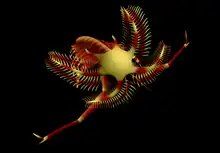

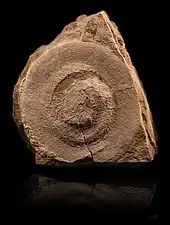
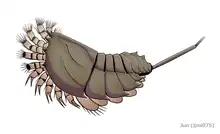

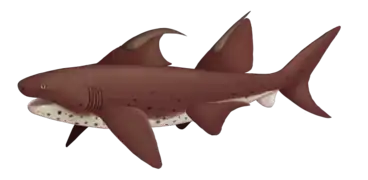
.JPG.webp)




